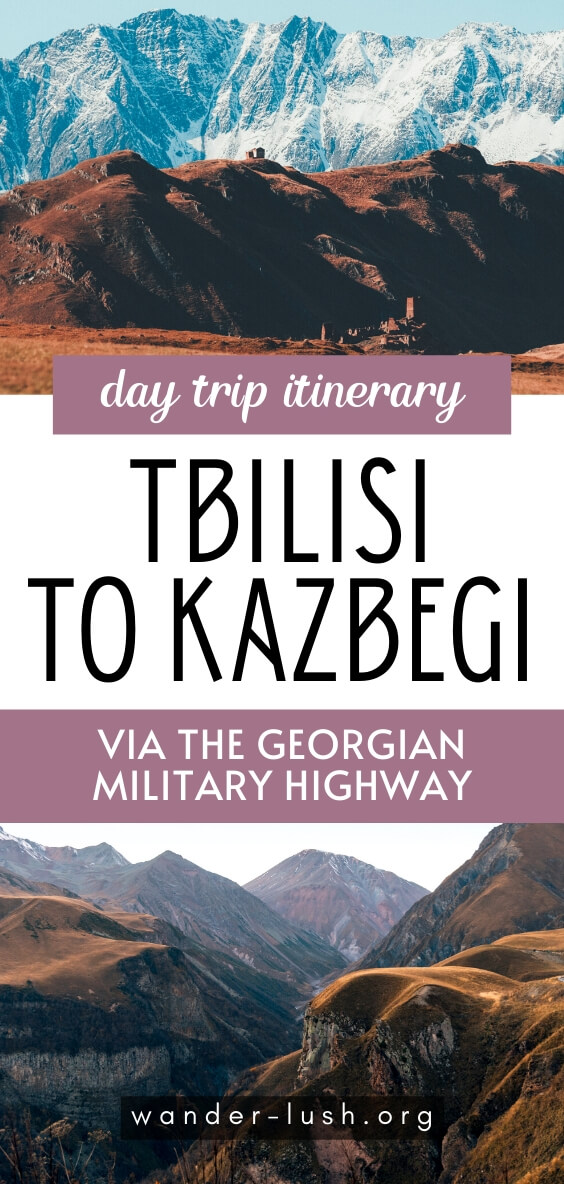12 Places to Visit on a Georgian Military Highway Road Trip
24 min readIf it’s majestic mountains that are calling you to visit Georgia, the Georgian Military Highway will feel like the road to heaven.
This 200-kilometre (124-mile) north-south arterial connects Tbilisi with Russia via the town of Kazbegi (Stepantsminda), home of the iconic Gergeti Trinity Church. Driving (or rather, being driven) along the Georgian Military Highway is one of the quickest and most convenient ways to immerse yourself in the Greater Caucasus.
I’ve travelled the Military Road a dozen times now (hence why my photos are a mishmash of summer, spring and winter scenes!). I have travelled by marshrutka, by taxi, on tours, and most recently in a private car.
Along with Svaneti, this remains one of my favourite mountainous areas to visit in Georgia.
When planning your journey from Tbilisi to Kazbegi (or the reverse route, Kazbegi to Tbilisi), don’t rush it. Take your time to soak up the views, inhale some mountain air, and do some sightseeing along the way.
Ideally, you should set aside a full day for driving the Military Highway and visiting the various churches, lookout points and monuments along the way. I promise it will be a highlight of your itinerary.
In this guide to Georgia’s most scenic road, I’ll introduce you to 12 places along the Georgian Military Highway that are more than worthy of a stop-off. You’ll also find instructions on how to travel the Georgian Military Road by van, taxi or private car.
Please note: This post contains affiliate links, meaning I may earn a commission if you make a purchase by clicking a link (at no extra cost to you). Learn more.
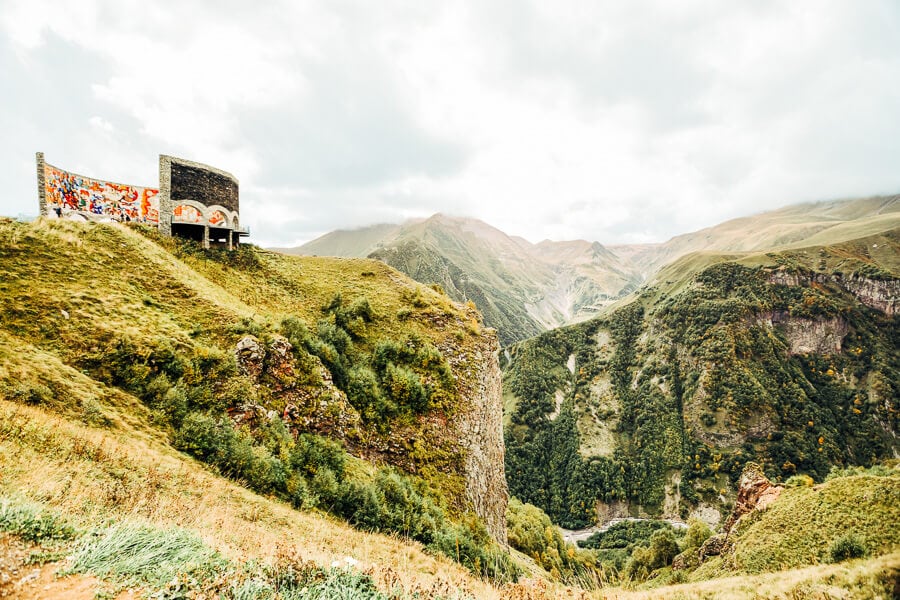
What is the Georgian Military Highway?
The Georgian Military Highway was first carved out by traders and invaders alike in the 1st century BC. There have been many iterations over the years, but its function as a land bridge between Georgia and Russia, Europe and Asia, has remained the same for centuries.
The E117 highway as it’s known today technically starts 30km north of Tbilisi, just before the village of Natakhtari. In the old days, the highway ran all the way to the capital.
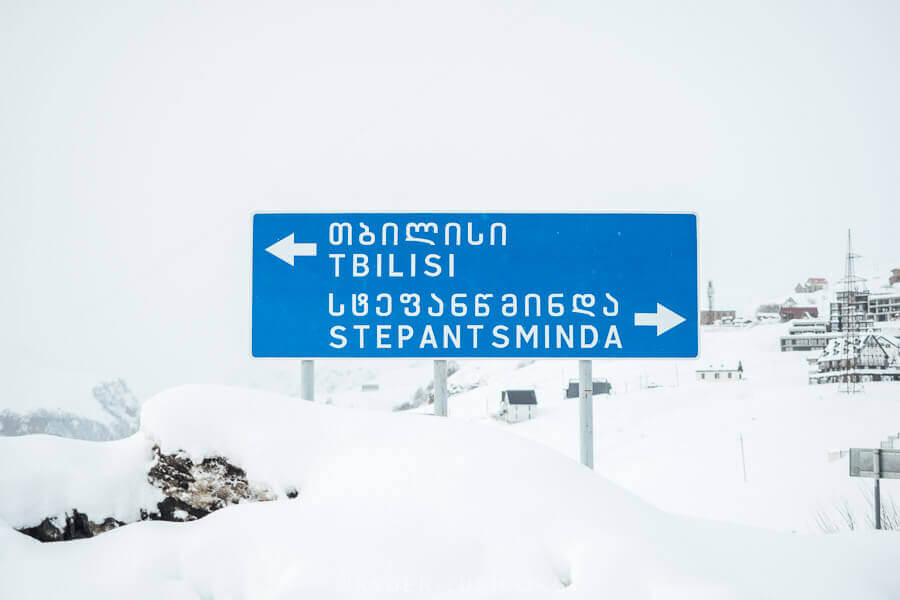
Most tourists travel the portion of the road between Natakhtari and Kazbegi. After Kazbegi, the highway continues all the way to the Kazbegi-Verkhni Lars border crossing before finishing at Vladikavkaz, the capital of Russia’s North Ossetia-Alania Oblast.
In the beginning, the road was the only pass through the otherwise impenetrable Greater Caucasus. As you move along the highway today, you can still see watchtowers and hideouts hewn from the rocky cliffs that rise up from the road shoulder.
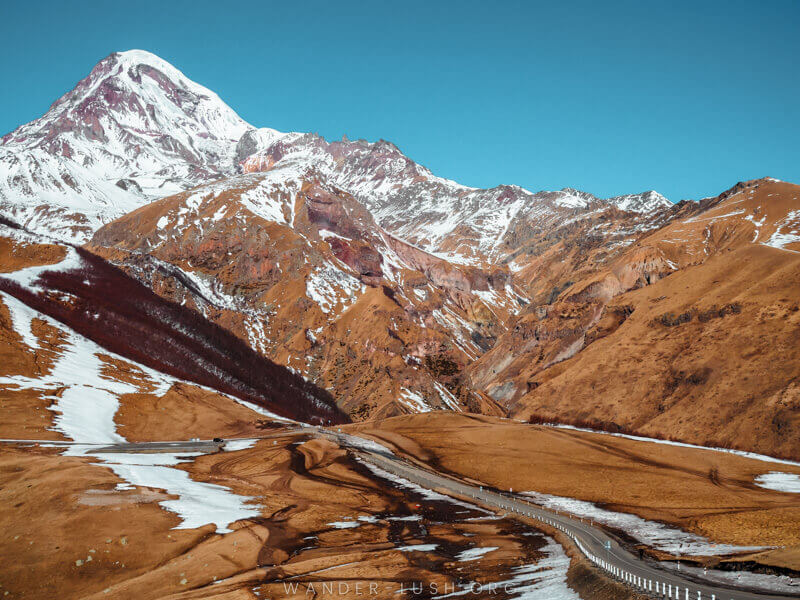
In the 1780s, a thousand-odd soldiers were given the unenviable task of converting the narrow horse track into a formal highway fit to accommodate carriages. A few decades later, when Georgia was annexed by the Russian Empire, the road was improved upon again and iron bridges were added.
At the time, the highway was heralded as the Caucasus’ answer to the Simplon Pass (the scenery is certainly on par!). So lovely was the landscape, Tolstoy and Dumas, among others, thought it prudent to make mention of the road in their writings.
As the only land link between the Trans-Caucasus region and Russia, the highway is still an important thoroughfare. Today, it’s lorries travelling between Russia, Turkey and beyond that ply the route. In winter, long queues of brightly coloured trucks often line one side of the asphalt.
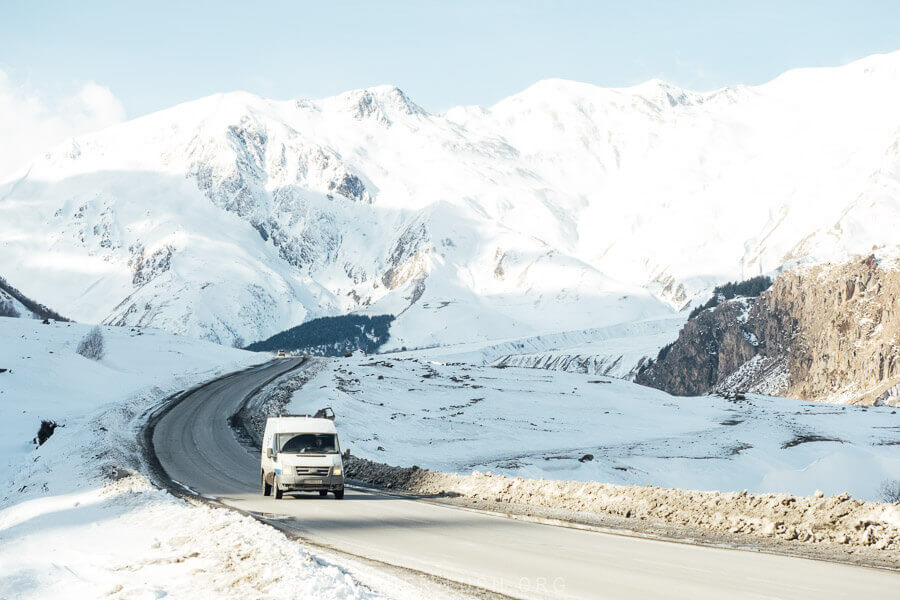
Galleries added to protect the road from avalanches aren’t wide enough for two trucks to pass each other safely, so the traffic must take turns. The tunnels are only open for a few hours a day, so it’s not uncommon for drivers to wait days – even weeks if the weather is bad – to pass through.
Although the road is open year-round, the section of highway between Gudauri and Kazbegi is prone to avalanches in winter and rockslides in spring. Usually the road is only closed for a few hours before it’s cleared, but on occasion closures do last for days on end (this happened several times in winter 2023/24, for example).
Before you set off to travel the Georgian Military Highway, it’s best to check the local weather and road conditions carefully. Geo Roads posts regular updates on their Facebook page and also has a hotline you can call for advice.
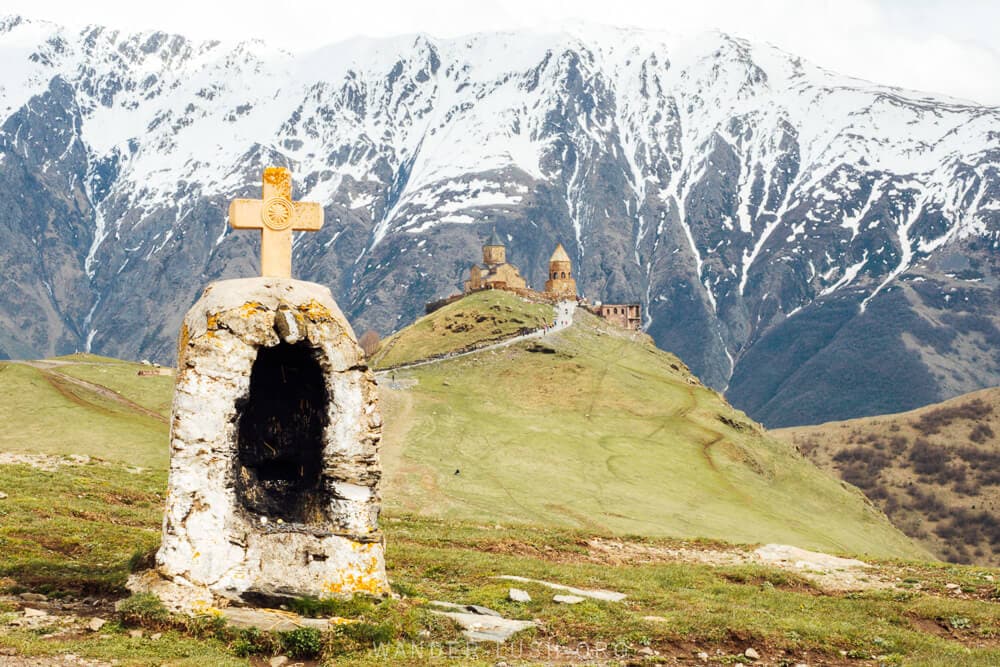
How to travel the Georgian Military Highway
To travel from Tbilisi to Kazbegi, you have four options: Marshrutka minivan, shared taxi, private car, or organised day trip.
Marshrutka van is the cheapest option, but the regular vans don’t make any photo stops (only a rest stop near Gudauri). Shared taxis offer more flexibility, but stops are at the discretion of the driver and other passengers. Similarly, organised day trips usually only include a handful of the 12 stops recommended below.
If you want to see everything at your own pace and pause at all the viewpoints for photos, then the best way to travel the Georgian Military Highway is by hiring a private car and driver for the day.
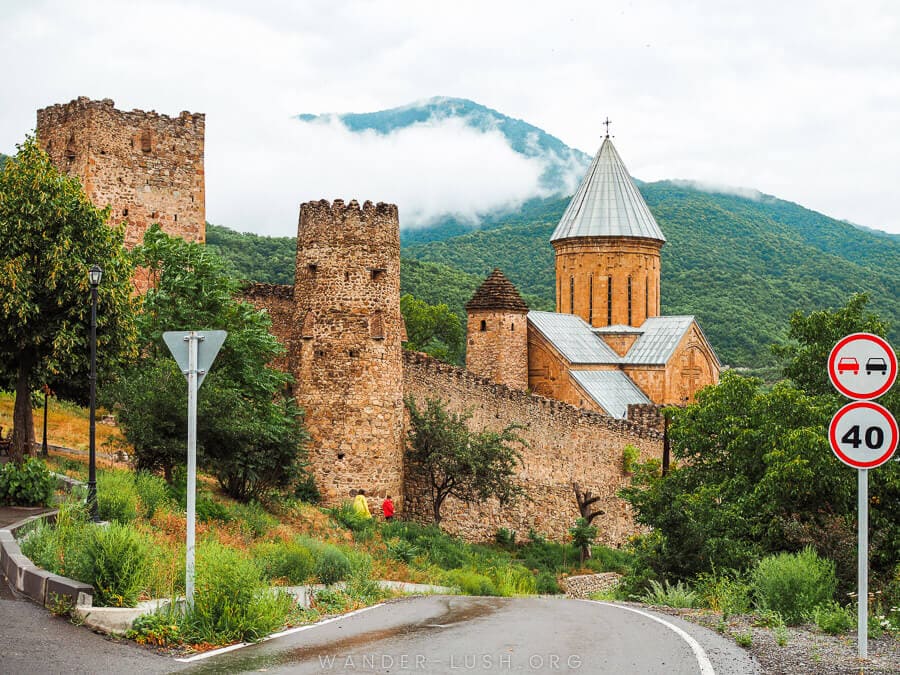
My preferred way to organise a transfer in Georgia is using GoTrip, an online service that pairs travellers and professional drivers. You can design your own itinerary by plugging in some (or all) of the 12 attractions below. You can stop for as long as you like at each, and even if you add additional stops on the day, the fare won’t change.
Prices are up to 40% lower when you book through GoTrip, and fares are set in advance, so you know exactly how much you have to pay (no negotiating required). You can stop wherever you want for photos or sightseeing – the only requirement is that you complete the trip within 24 hours.
If you need more time, you can book a multi-day transfer with GoTrip and stick with the same driver for an extended period.
This day trip itinerary I designed for a round-trip on the Military Highway (Tbilisi – Ananuri – Pasanauri – Gudauri – Dariali – Kazbegi – Tbilisi) starts from just $70 per car.
Read my full review of GoTrip for more information on how to use the service, and what to expect.
If you fit all your sightseeing into one day, you can take a cheaper van or taxi back to Tbilisi from Kazbegi. This is exactly what we did on our most recent trip.
It’s also possible to hire a car and drive yourself to Kazbegi, but unless you’re experienced with mountain roads and confident with Georgian traffic, I don’t recommend it. If you’re feeling brave and you do decide to go this route, you can find a great deal on a hire car through Local Rent.
Day tours along the Georgian Military Highway
Georgian Military Highway road trip: 12 places to stop between Tbilisi and Kazbegi
This Georgian Military Highway Travel Guide covers 12 terrific places to stop between Tbilisi and Kazbegi. At the end, there’s a map you can use to plan your own travel route.
Every time I travel this road, I find new places to stop. So there are now some bonus secret spots included too!
Note that there are lots and lots of ‘tourist traps’ along the Military Highway – scenic lookout points where mass-produced souvenir markets have popped up, and you can pay to have your photo taken in a papakha hat. I personally try to avoid these spots and have not included them on the list.
1. Jvari Monastery of Mtskheta
- Travel time from Tbilisi: 30 minutes
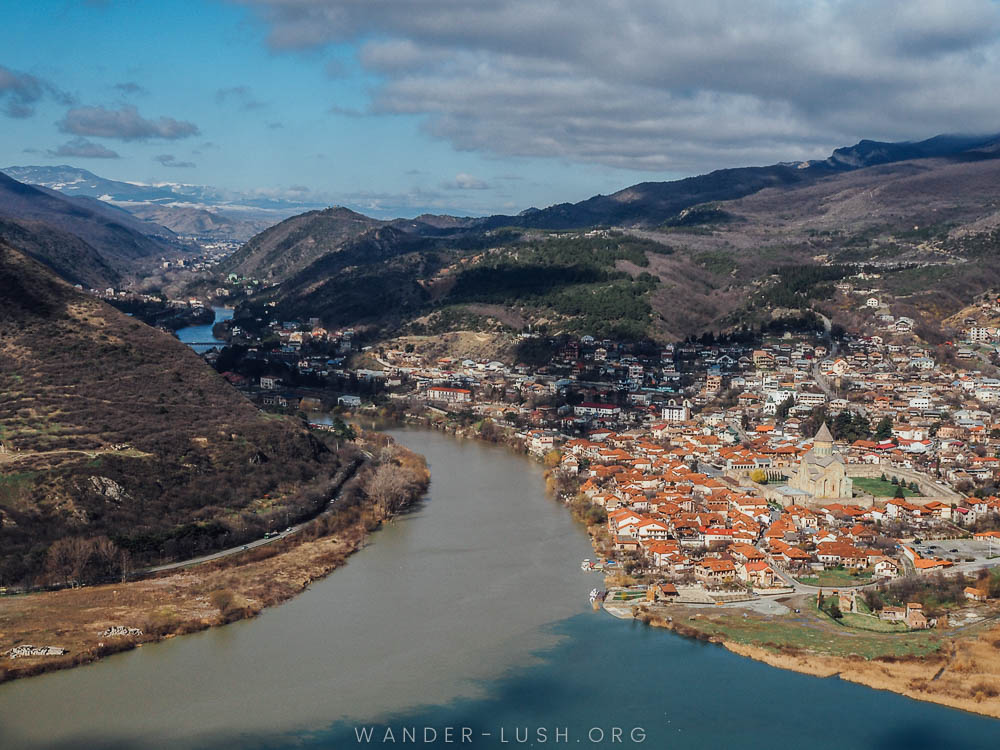
Though not technically on the Georgian Military Road (we haven’t got there just yet), Georgia’s former royal capital, Mtskheta, is located just off the highway 25km north of Tbilisi. If you haven’t yet had a chance to visit Mtskheta on a day trip from Tbilisi, it’s worth the very slight detour to visit Jvari Monastery and potentially the old town and Historical Monuments of Mtskheta, one of Georgia’s four UNESCO World Heritage Sites.
Mtskheta’s must-see, Jvari sits on a hill on the eastern bank of the river. On the drive up and from the church yard, you get a stunning panorama of the valley and the confluence of the Mtkvari and Aragvi Rivers.
The enormous 11th-century Svetitskhoveli Cathedral (visible on the bottom right in the photo above) is located in the centre of Mtskheta. This Orthodox church houses the remains of two Georgian monarchs, kings Erekle II and Vakhtang Gorgasali.
Alternative route: Sabaduri Forest


If you have already been to Mtskheta and you have time to modify your route slightly, you can first head north-east from Tbilisi towards Tbilisi National Park to visit Sabaduri Forest and the Zoological Centre in Tskhvarichamia.
I especially recommend this detour during winter, as Sabaduri is pure magic in the snow. The Zoological Centre, an ethical animal rescue shelter that is home to 20 Eurasian brown bears, is particularly fun for kids.
On the way up from Tbilisi, you will pass stacks of incredible Soviet-era mosaics along the highway and clustered around the former Pioneer’s Camp in Tsiskari. See my Sabaduri Forest Guide for the locations.
Once you have seen Sabaduri, you can backtrack slightly and head west on the sealed Saguramo road. This will bring you to the Georgian Military Highway at Tsitsamuri, just outside Mtskheta.
2. Zhinvali Reservoir & confluence of the Black and White Aragvi
- Travel time from Jvari Monastery: 45 minutes
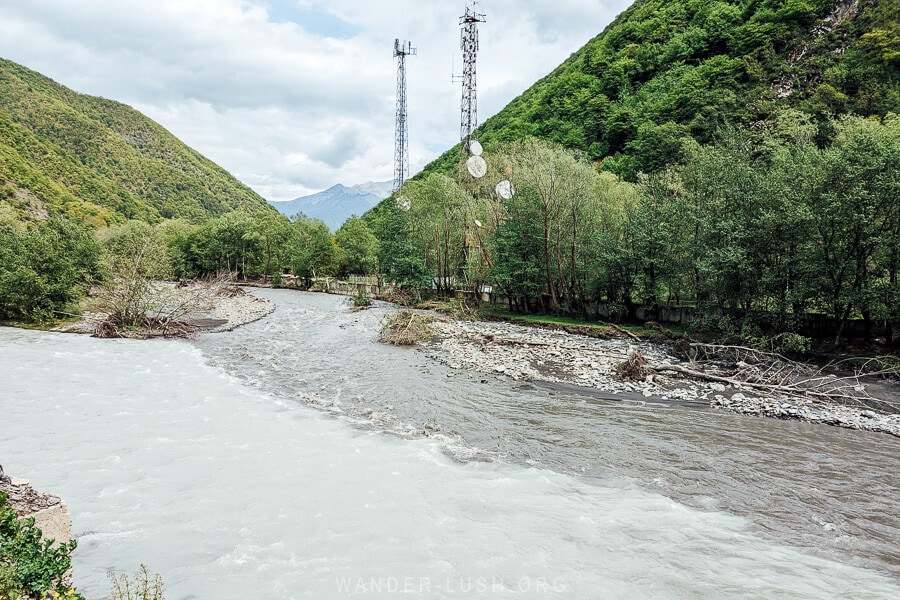
The first point of interest on the Georgian Military Highway proper is Zhinvali Reservoir, 40km north of Mtskheta. There are a series of viewpoints just off the highway where you can stop for a quick photo. From here, you can appreciate the scale of the man-made lake and its surreal blue waters.
Like nearby Sioni and other reservoirs across Georgia, Zhinvali was created when a dam was installed, flooding the valley. In this case, it happened in 1986. When the waters were let loose, part of the old Georgian Military Highway that ran through the valley was completely submerged. So too was a small village.
In winter, when the water level is low, you can see parts of the old road and its narrow bridges. You can also see evidence of the village that was erased from the map. The tiny stone church clinging to the reservoir wall is a very melancholy sight indeed.
After the reservoir near Pasanauri there is a point where two branches of the Aragvi River, ‘black’ and ‘white’, meet. This creates an impressive natural phenomenon where the dark and light waters merge into one.
In spring you can go whitewater rafting on the Aragvi. I do recommend exercising caution with this, however, as it can be dangerous (there was a bad accident in spring 2023). Aragvi Adventure Center is a reputable outlet.
At the confluence of the rivers you’ll see an unusual sculpture…
Bonus stop: Monument of the 300 Aragvians
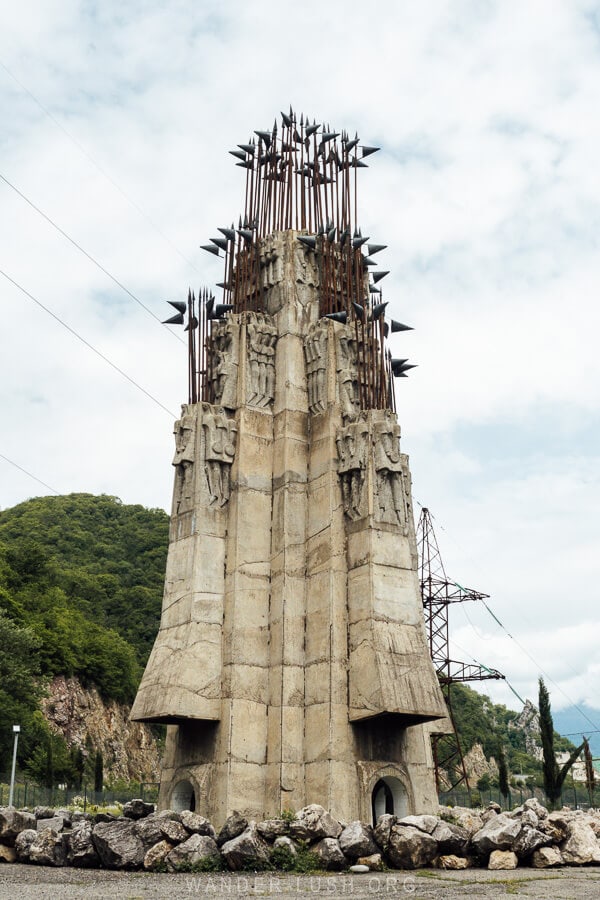
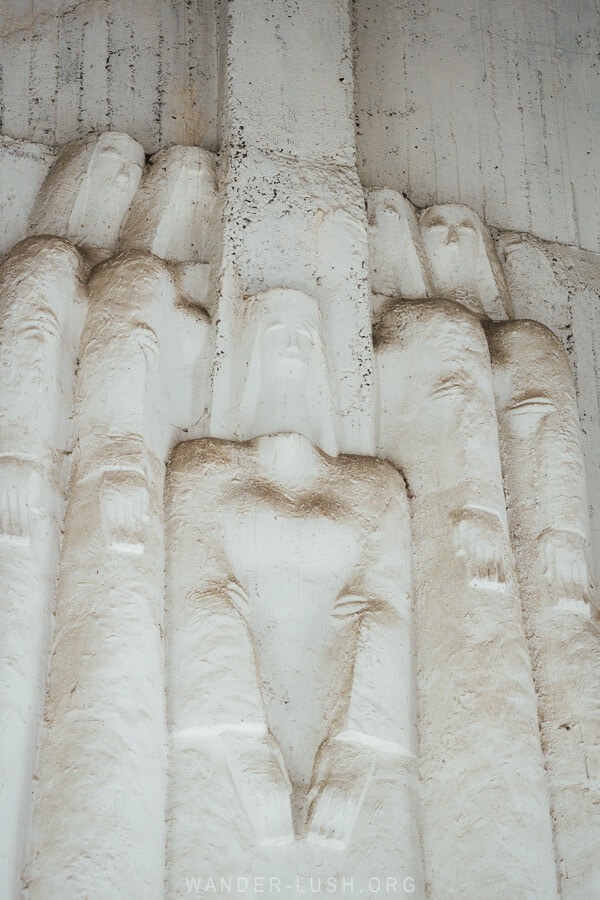
The Monument of 300 Aragvians (or 300 Aragveli) is dedicated to the fighters from the Aragvi Valley who made a last stand at the Battle of Krtsanisi in 1795. They were fighting against the invading Qajar (Persian) army, who took the capital and destroyed most of Tbilisi in the process.
The Soviet-style monument was built in 1959 and designed by architect A. Bakradze. The spear-clad exterior is quite impressive, but make sure you also step inside to see the haunting bas-reliefs.
Related: If you’re interested in war memorials, I highly recommend visiting the Didgori Battle Memorial south-west of Tbilisi.
3. Ananuri Fortress
- Travel time from Zhinvali Reservoir: 12 minutes
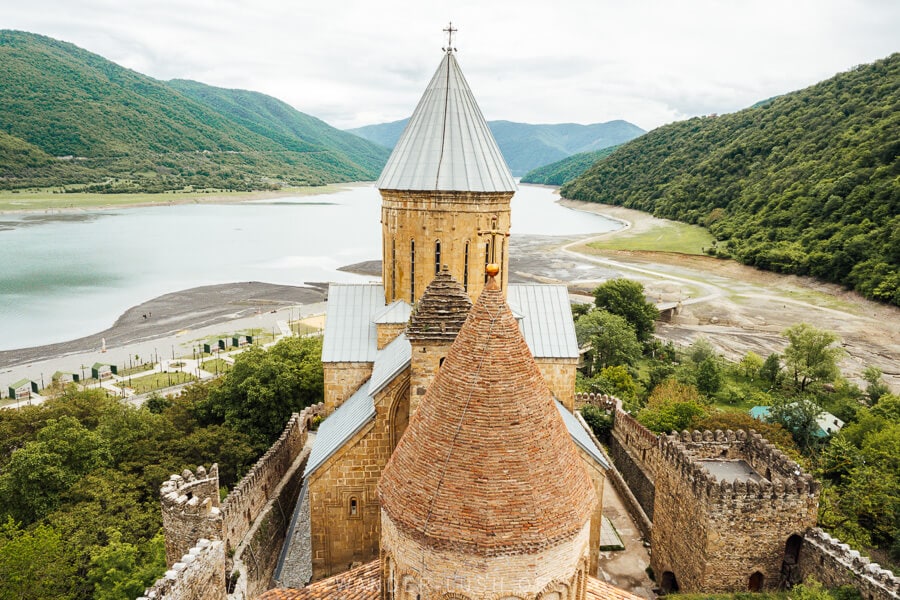
It’s only another 10km from Zhinvali to Ananuri Fortress, one of the most popular stops on the Georgian Military Road. The walled complex dates back to the 13th century when the region’s leaders built two defensive castles on the bank of the Aragvi River. The main building, the silver-crowned Church of the Mother of God, was added in 1689.
The most interesting thing to see at Ananuri, in my opinion, is the stone carvings on the church facade. As you enter through the gates, you’re greeted with a massive stone wall dressed head to toe with the plump curls of the Georgian script, an earlier version of the alphabet used today.
On the back of the church there is a beautiful design of a tree. Also note the carvings of angels with almond-shaped eyes.
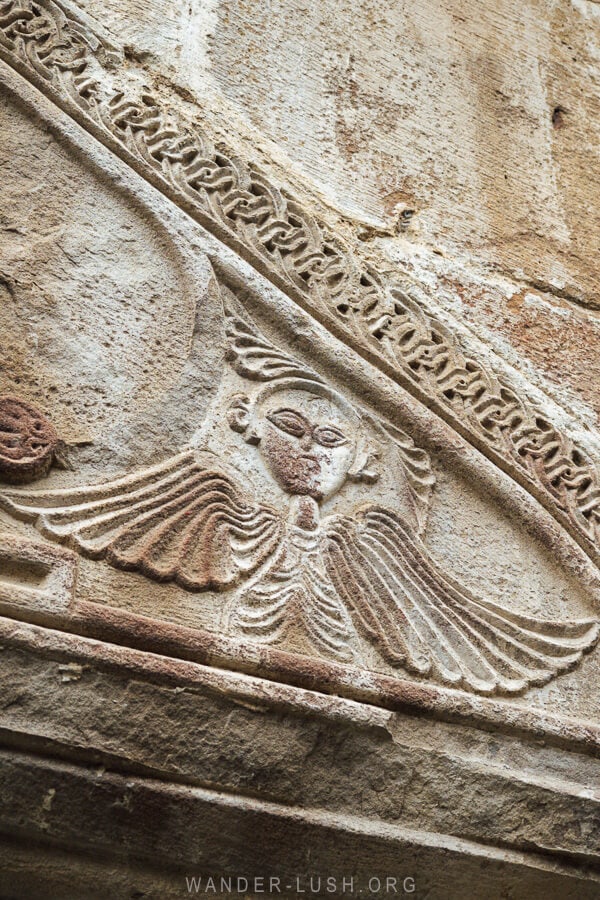
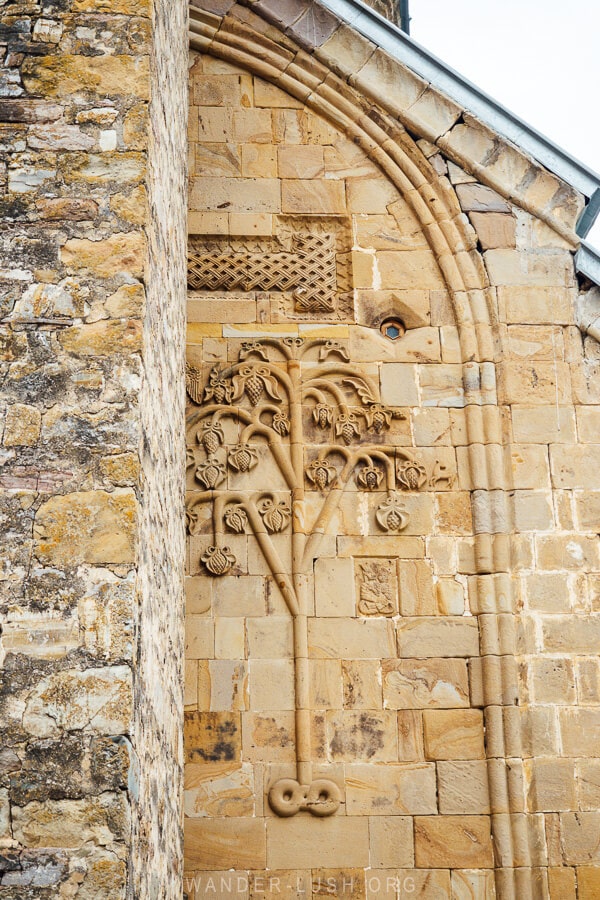
Don a skirt and headscarf and go inside the church, where you’ll find partially restored frescoes illuminated by votive candles.
Then head to the back of the complex to summit the stone tower. From the top floor (and from the arrow-slit windows on the way up) you get a view of the two Ananuri churches and the top of another stone tower stacked horizontally, with a panorama of the river and hills beyond.
The stairs are precarious but the views are absolutely worth the climb!
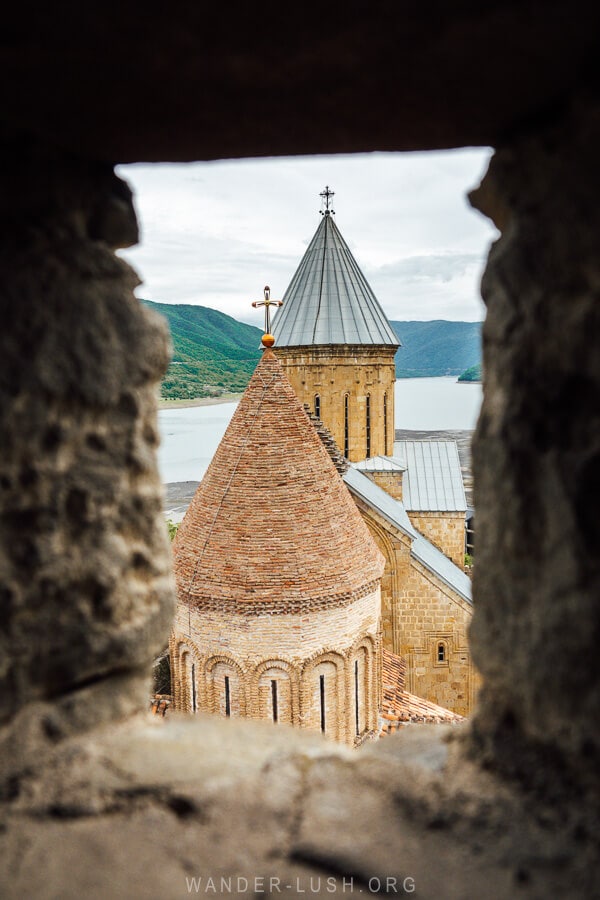
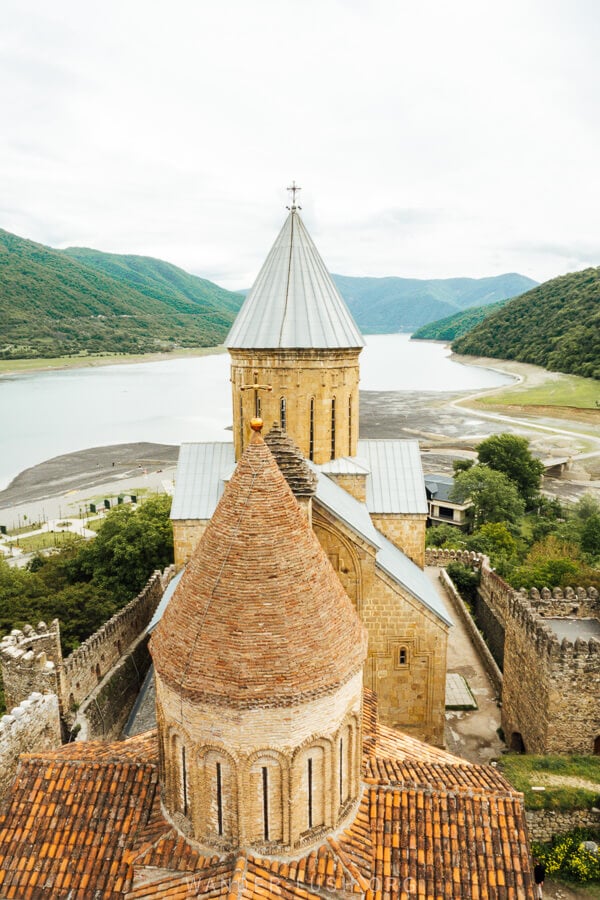
The best view of the fortress complex itself is from the nearby bridge. From there, you can see more evidence of the old highway (a concrete bridge that’s only exposed in the dry months) as well as the remains of the second, lower part of Ananuri Fortress.
There are snack stands and cafes in the parking lot if you need to grab a churchkhela or something to drink. Note that parking costs 3 GEL – or you can drive down the hill past the main gate and park for free on the street.
Bonus stop: Tsikhisdziri bus stop mosaic
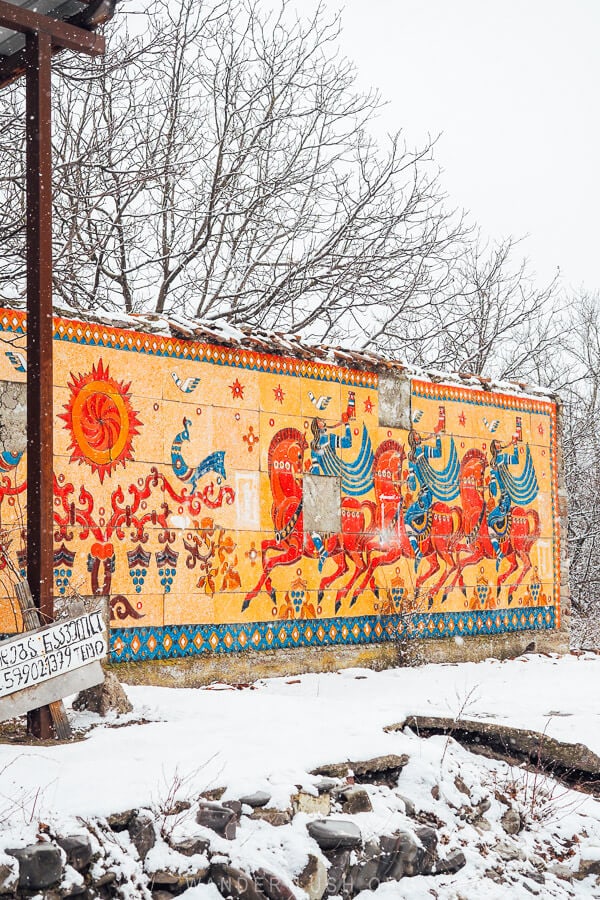
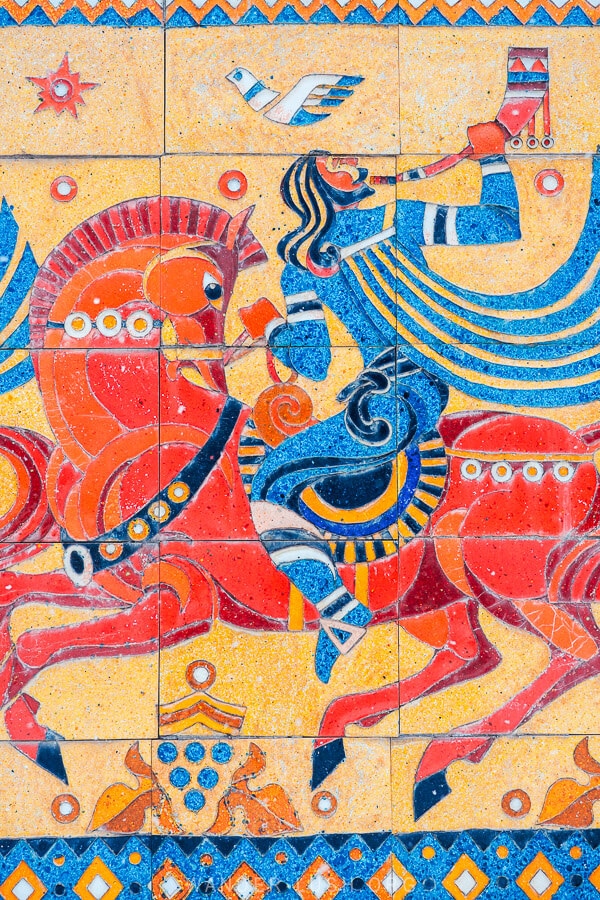
This former bus stop is one of many Soviet-era mosaics along this route. It is one of my favourite in all of Georgia.
The colourful panno is inspired by folk tales and legends. It depicts lions, pheasants and trumpeting horsemen, with passages of text in both Russian and Georgian.
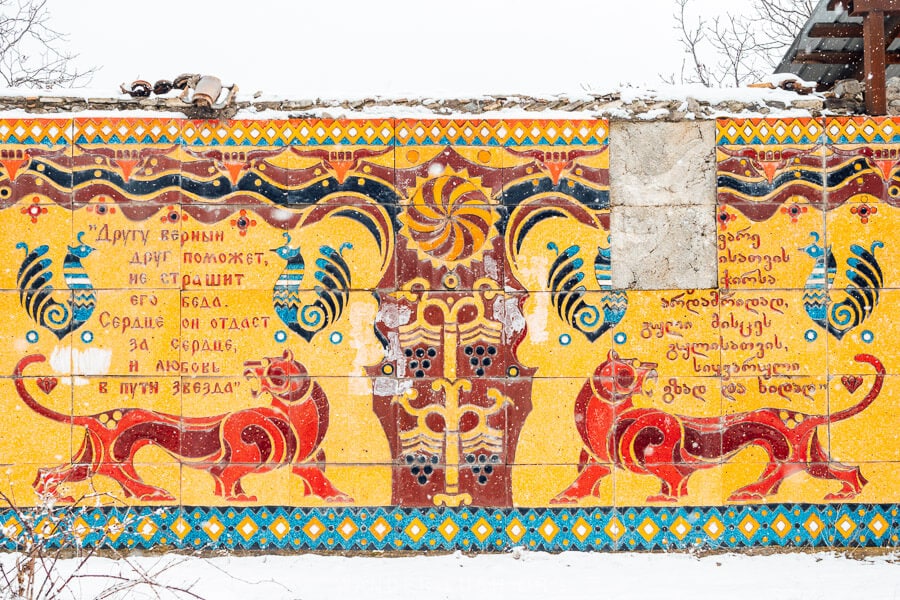
The mosaic was created in the 1970s and is attributed to the architect Giorgi Chakhava and artist Zourab Kapanadze. In 2020 it was partially restored.
Find it on the right shoulder of the highway in Tsikhisdziri, the next village after Ananuri.
4. Pasanauri village, the birthplace of khinkali
- Travel time from Ananuri: 30 minutes
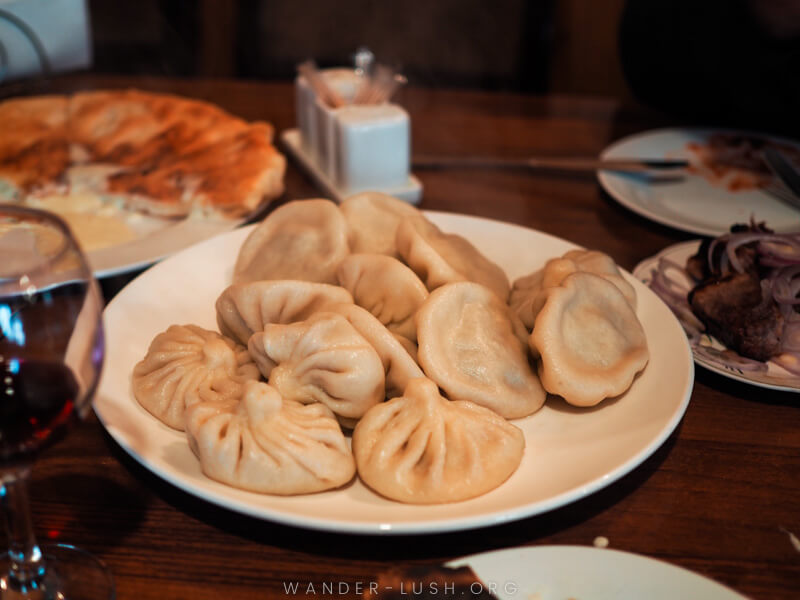
Many people refer to Pasanauri as ‘the home of khinkali’ (there’s even a chain of restaurants in Tbilisi named after the town). I can confirm that the soup dumplings here are some of the best in the entire country.
Pasanauri is the best place on the highway to stop for lunch – the difficult part is choosing which of the half a dozen restaurants to try.
On our latest trip, we originally planned to eat at Restaurant Guda (one of the fancier restaurants that comes highly recommended). But on our driver’s recommendation, we ate at Korbuda instead.
Not only do they serve some of the most succulent, tasty khinkali I’ve ever eaten, they also make the best Imeretian khachapuri I have ever had – hands down. I’ve since eaten at a bunch of other restaurants in Pasanauri and they have all been excellent.
Believe me when I tell you it’s worth driving up from Tbilisi just for the food!
5. Vintage Car Graveyard
- Travel time from Pasanauri: 2 minutes
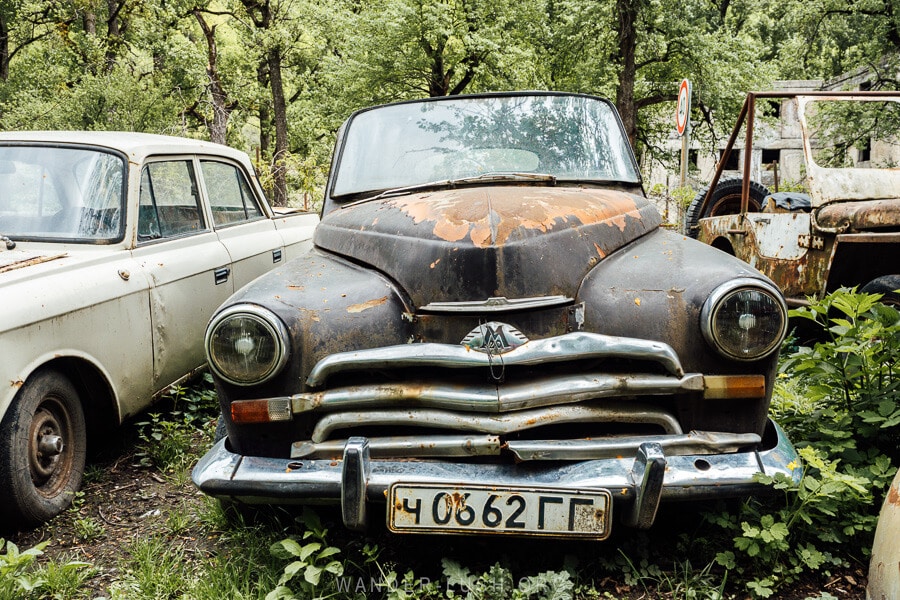
Also in Pasanauri, this quirky attraction is worth a look-in if you’re a fan of vintage cars and/or Soviet memorabilia. Located right off the highway, the Pasanauri Car Graveyard it is a small parking area where a few dozen Soviet-era automobiles are piled up.
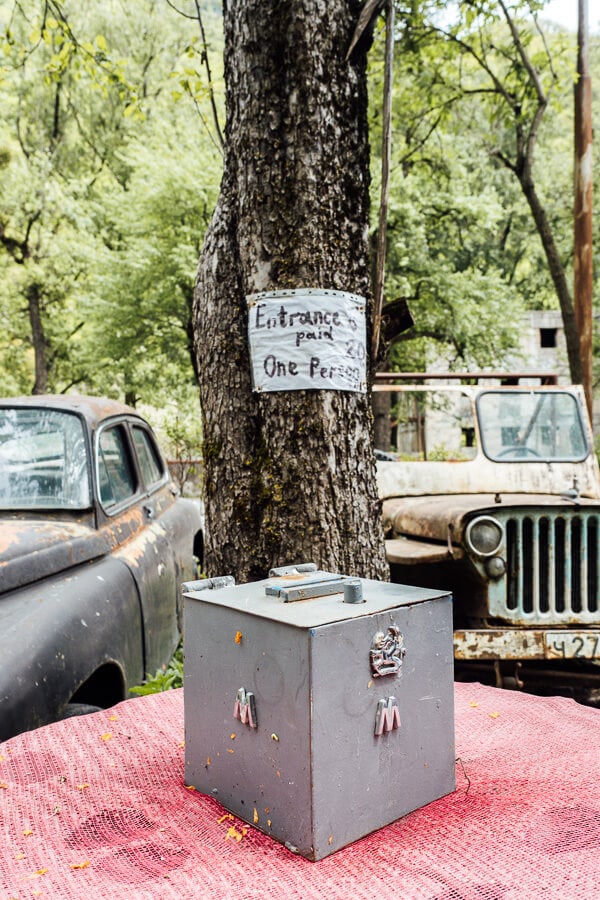
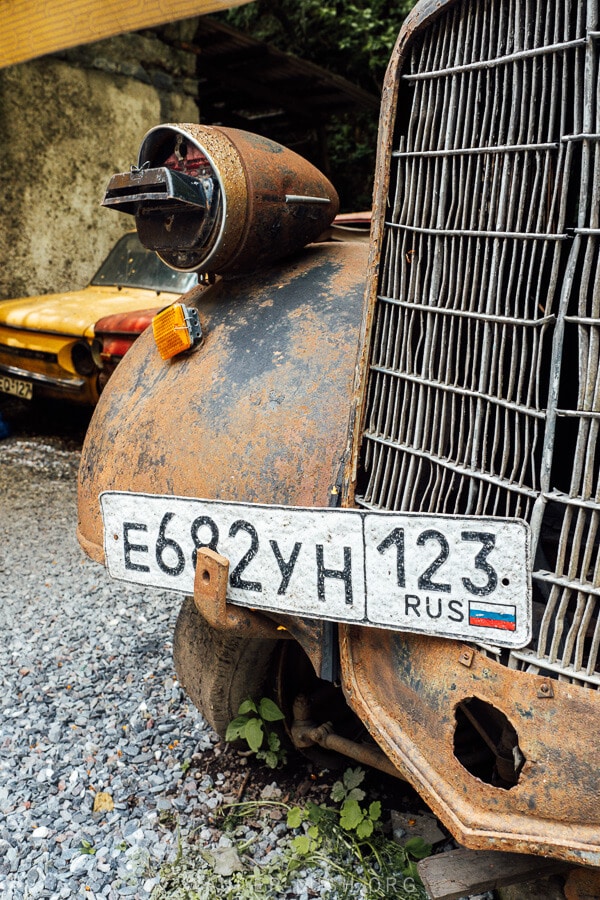
Apparently this is a private collection belonging to one man, who put his cars on display for the public almost by accident. Most of the cars are rusted out and charming in their state of decay.
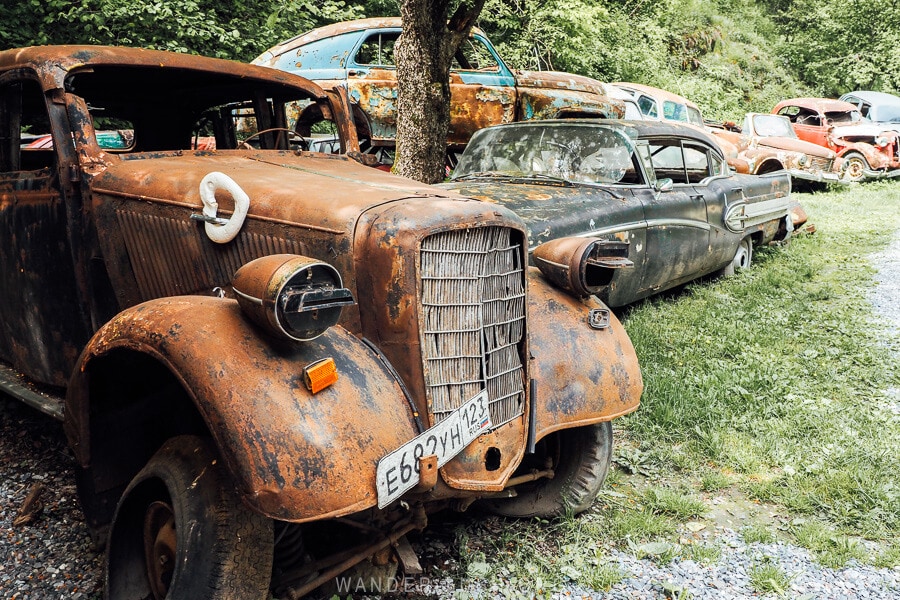
Entrance is by donation. There is a grey box set up on a table inside the lot. I mistakenly thought it said 20 tetri, not 20 GEL! So I dropped a few coins in and went on my merry way.
You will notice that this place has terrible reviews on Google Maps because of the entrance fee. It is very steep and unjustifiable in my opinion (the Tbilisi Auto Museum, for example, costs 10 GEL, and it’s a proper museum). Personally I would not pay 20 GEL for this – the area is very small and unkempt. But it’s up to you. (My driver, Mindia, knew the owner personally which is why we got away with paying 20 tetri.)
Also note that there is a ferocious guard dog on the property – a classic junkyard dog! – chained up at the entrance.
Interested in Soviet cars? Also visit the UAZ Graveyard in Zugdidi.
6. Nadibani Spring & Travertine Mineral Springs
- Travel time from the car graveyard: 10 minutes
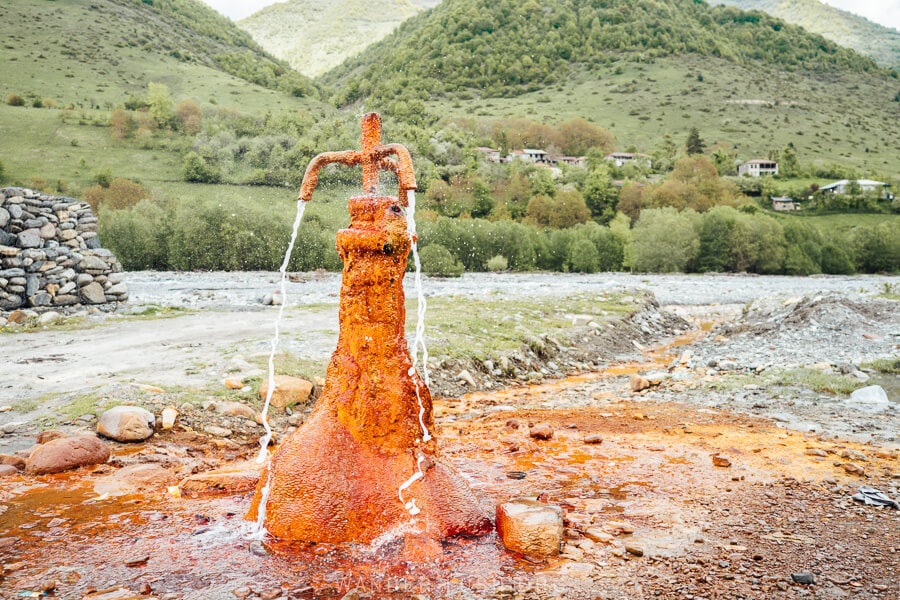
There are dozens of sulfur and mineral water springs all along the highway where you can stop and fill up a water bottle or two. For locals, this is part of the ritual of driving the Military Highway.
The spring pictured here is called the Nadibani Spring. It releases a never-ending torrent of mineral water known locally as Vedza water.
I was more than a bit skeptical when I saw it was caked in rust-coloured mineral deposits – but according to every local I have ever travelled this road with, the water is highly sought-after for its therapeutic benefits.
It is refreshingly bubbly but the taste is very metallic! If you let it sit overnight, the sediment settles to the bottom of the bottle and the water turns bright orange.
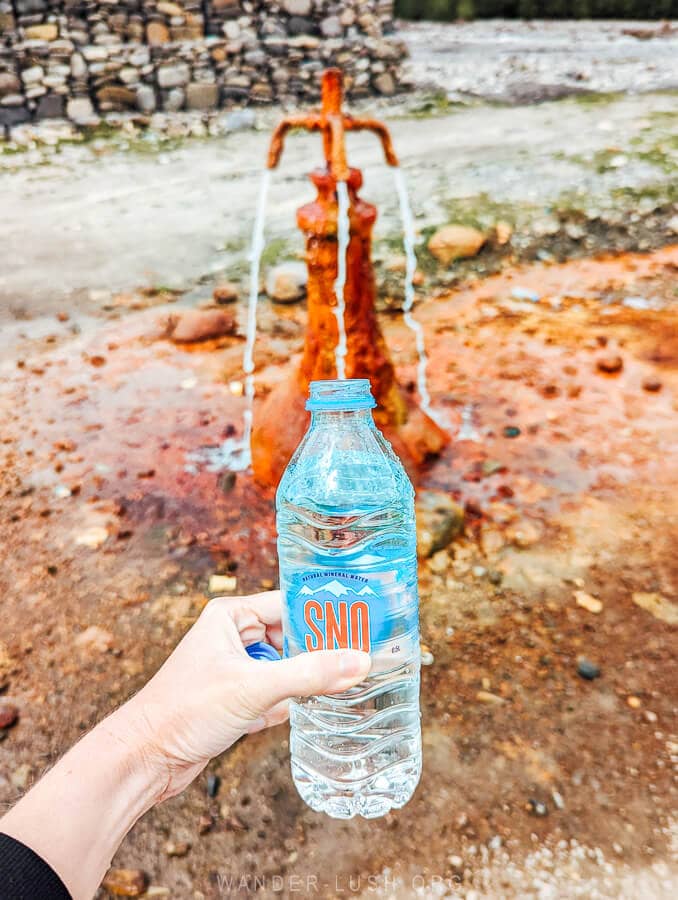
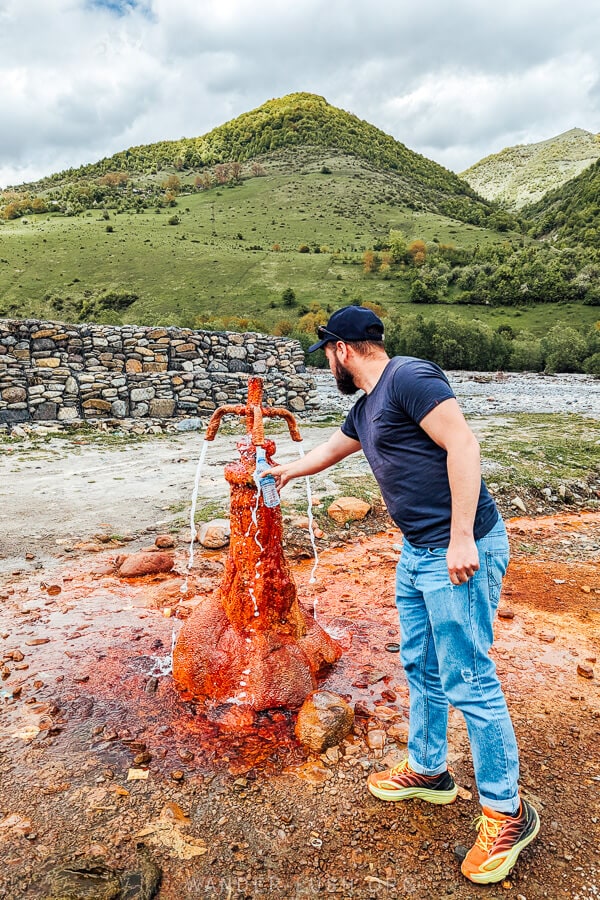
Further on, just as you emerge from the tunnel after Gudauri, you’ll see a large hill painted with rainbow colours. These are the spectacular Travertine Mineral Springs.
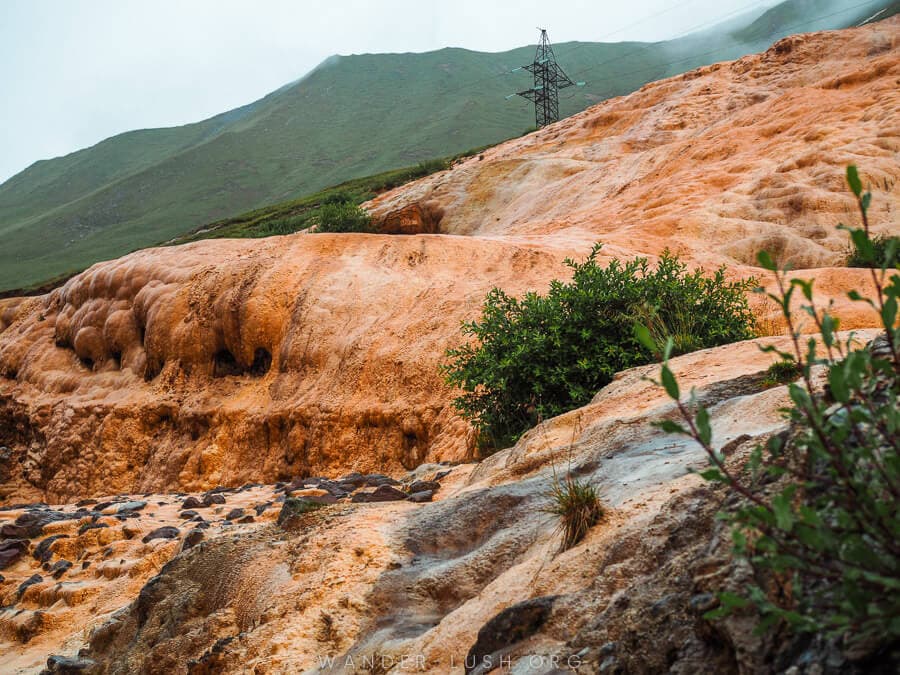
Travertine is a sedimentary rock formed by carbonate minerals and bubbling geothermal hot-springs beneath the surface. The vivid colours on the rock face are a result of different mineral deposits.
You can climb a little ways up the wall and sample the water that trickles down the rocks.
Bonus stop: Crazy Holy Spot
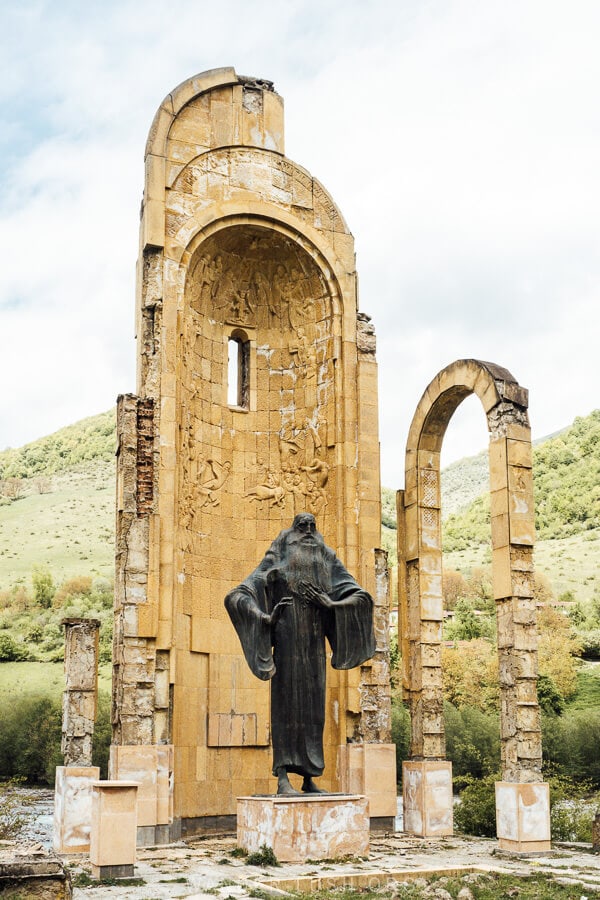
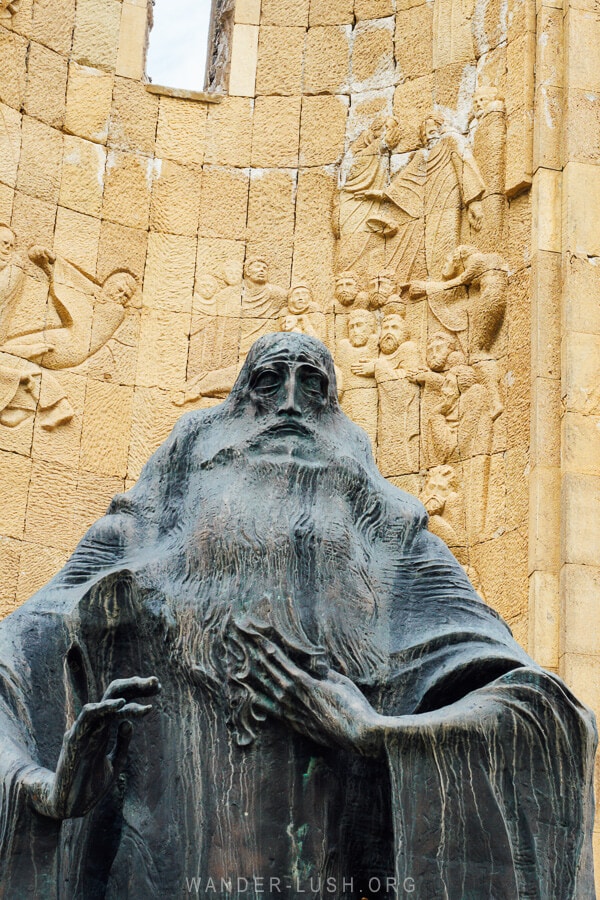
Marked ‘Crazy Holy Spot’ on Google Maps, this unusual monument on the riverside is one of my favourite quirky finds on the Military Highway. It depicts Sulkhan-Saba Orbeliani, a famous 17th-century writer and diplomat who was born in Tandzia in southern Georgia and famously travelled to the Vatican to seek assistance for King Vakhtang, the founder of Tbilisi.
Sadly the date and author of the sculpture are unknown. I have no idea if the stone monument has been damaged or if this was its intended form – but either way, it is very impressive. Orbeliani’s withered hands and blank stare are haunting.
Find it behind the shop off the highway, just before Nadibani Spring.
7. Gudauri
- Travel time from Nadibani Spring: 35 minutes
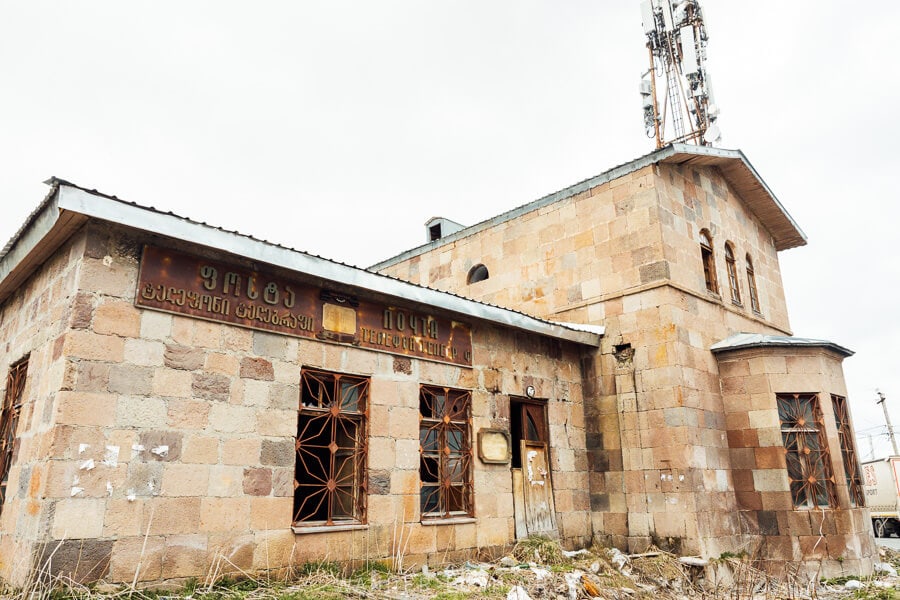
After Sakuriani, the road gets progressively curlier and steeper as you start to ascend into the mountains for the final stretch of the trip to Kazbegi. The landscape immediately changes from flat plains to lofty mountains as you enter the Gudauri Recreational Area, which is actually higher than Kazbegi.
Gudauri is one of Georgia’s premier ski resorts. As you pass through town, you’ll see the road is lined with chalets and cabins. Chairlifts rise up from the hills beyond the road, ferrying holiday makers up to the ski fields.
You have the option here to stop off and ride the cable car to Kobi, which runs throughout winter and during summer. It takes around an hour to traverse the four consecutive gondolas through the Jvari Pass, with awe-inspiring views of Mount Kazbegi along the way. Ask your driver to meet you at the final station in Kobi village, then rejoin the Military Road from there.
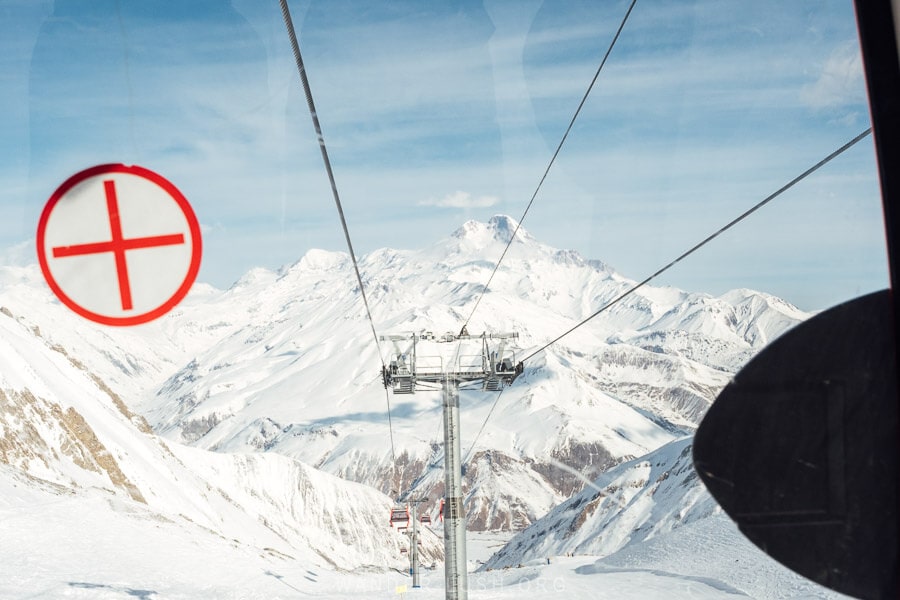
There is literally nothing to see in Gudauri town itself apart from the old Gudauri Post Office, which I think is a bit of a hidden gem! Before the ski resort was established in 1988, this was the only landmark in the area. It served as a post office for people from the surrounding mountain villages. This makes it the oldest building in town.
Sadly the stone building is abandoned and in a bit of a state. It is screaming out for someone to transform it into a cool cafe or boutique hotel! The decorative metalwork and signage in Georgian and Russian letters is very cool.
8. Russian-Georgian Friendship Monument
- Travel time from Gudauri: 10 minutes
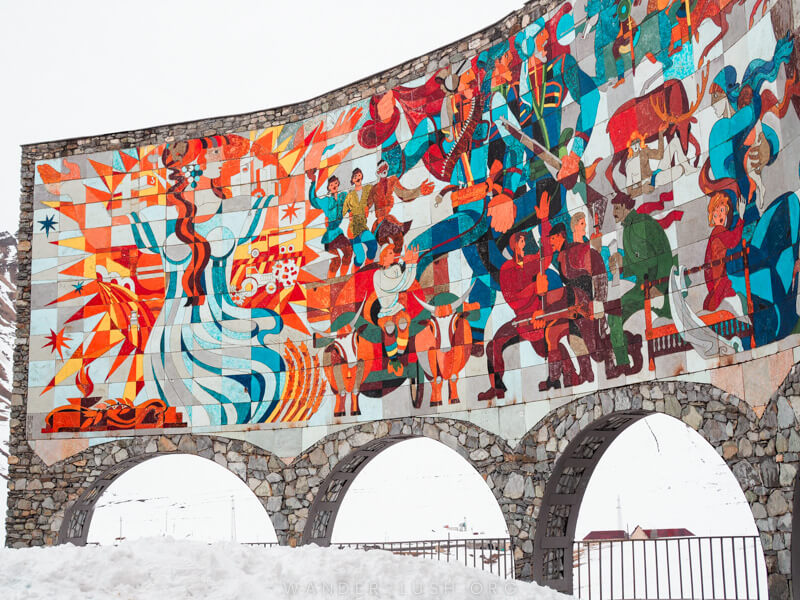
Located just 10 minutes’ drive from Gudauri, the Russian-Georgian Friendship Monument is without a doubt the most iconic landmark on the Georgian Military Highway. The much-photographed semi-circular mosaic is perched on an outcrop overlooking one of the most scenic parts of the mountain range.
The monument was built in 1983 to commemorate the 200-year anniversary of the Treaty of Georgievsk and celebrate diplomatic relations between Georgia and its neighbour to the north. It was designed by Georgian architect George Chakhava, and the colourful mosaics are the work of artists Zurab Kapanadze, Zurab Lezhava and Nodar Malazoni.
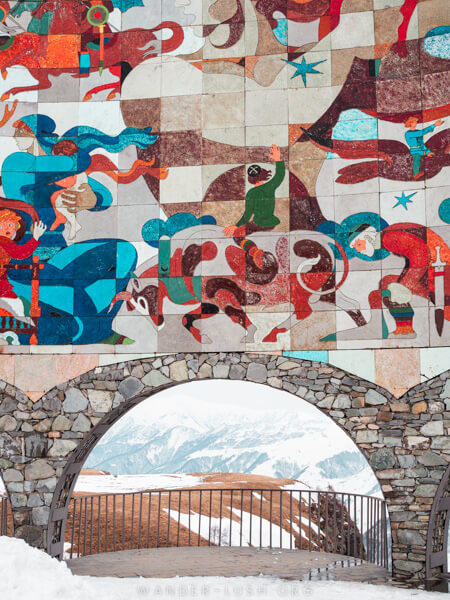
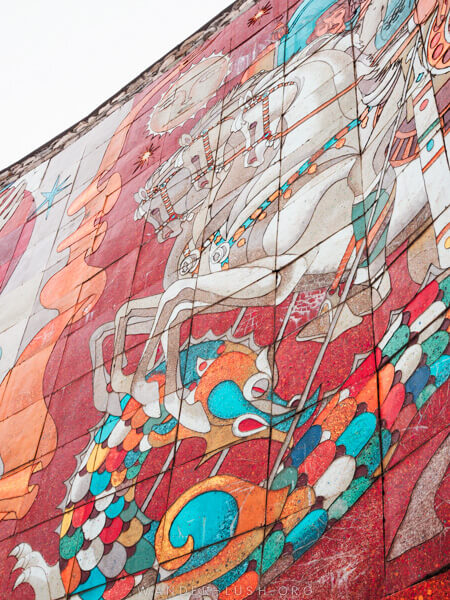
The interior mural is an abstract panorama of different scenes from Georgian and Russian history. The narratives converge at the centrepoint where a mother and child embrace, a Georgian Orthodox church on one side and a Russian Orthodox church on the other.
Stone archways along the bottom of the monument open out to a series of balconies, each of which reveals amazing views of the so-called Devil’s Valley below. As you look down, you can see an emerald eye staring back at you – a water reservoir cut from the valley floor.
9. Jvari Pass
- Travel time from the Friendship Monument: 3 minutes
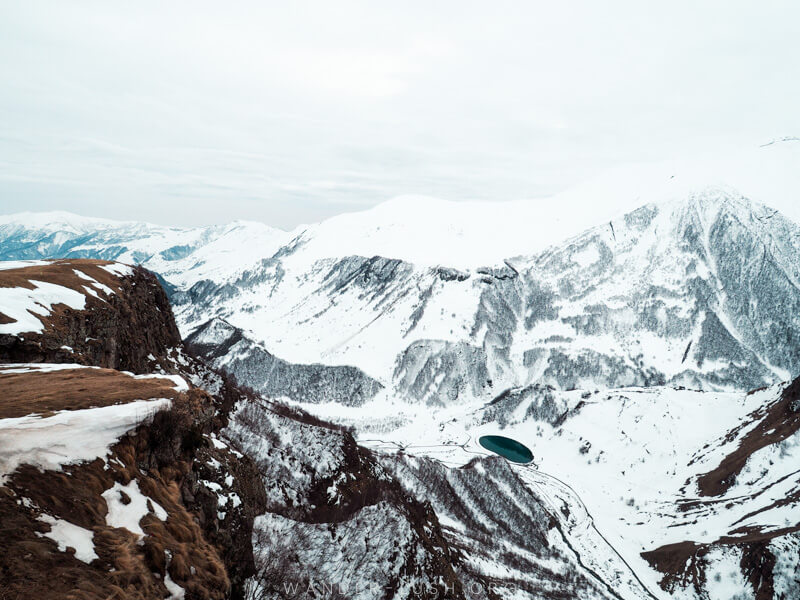
The final stretch of the Georgian Military Highway after Gudauri and the Russian-Georgian Friendship Monument is the most scenic. Here, the road reaches its highest point (2395 metres above sea level) – and your trip will reach its crescendo – as you glide along the Jvari Pass and back down into Kazbegi.
It’s here that you start to appreciate the grandeur of the Greater Caucasus. Covered in snow or wrapped in a blanket of emerald-green foliage, it’s stunning no matter the season.
On the left, you’ll see a small cemetery where a group of German POWs captured during WWII are buried. Many of the bridges and tunnels on the Military Road are a result of their hard labour.
The Jvari Pass is a wind-down-the-window moment – take in the awesome views and soak up the fresh air for the final 25km stretch of the drive to Kazbegi.
Don’t get too relaxed, though – there are still a few more stops to go!
10. Sno Giant Stone Heads
- Travel time from Jvari Pass: 35 minutes
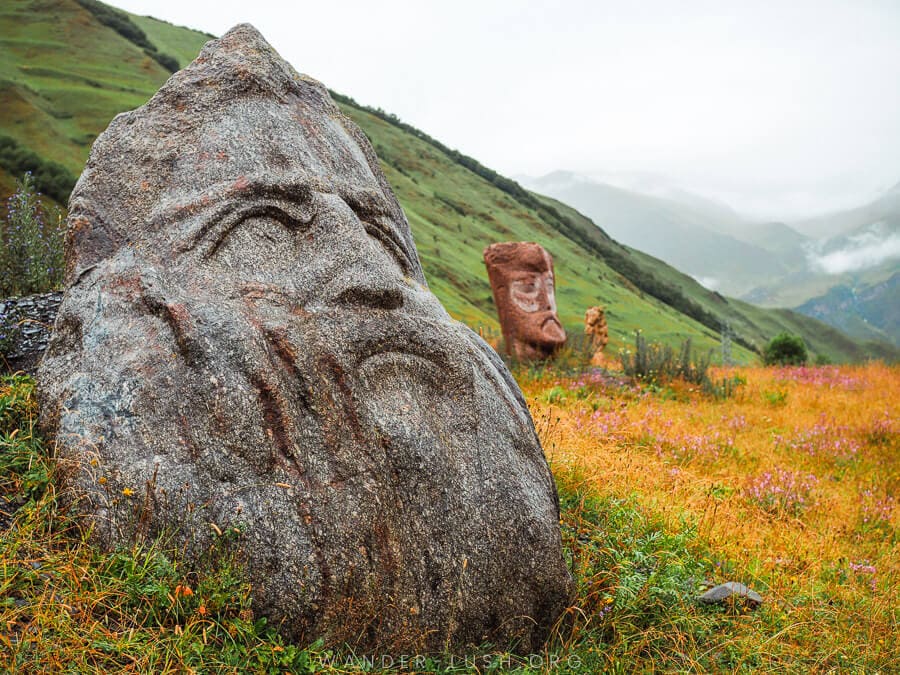
Sno is a short detour off the highway just before you reach Kazbegi, but it’s worth a quick stop if you have time. This tiny, idyllic alpine village is best-known for its mineral water springs (you can buy Sno water in supermarkets around the country) and for being the hometown of Georgia’s sitting Orthodox Patriarch.
It’s also home to a rather odd attraction – something called ‘Gigantic Sculptures’ on Google Maps. Just before you reach the village, you’ll see a collection of a dozen or so larger-than-life stone heads scattered around a rolling field.
Each one bears the profile of one of Georgia’s most beloved national poets. The solid stone sculptures are the work of local artist Merab Piranishvili, who wishes to create 500 in total. Some people call this Georgia’s very own Easter Island – you can be the judge!
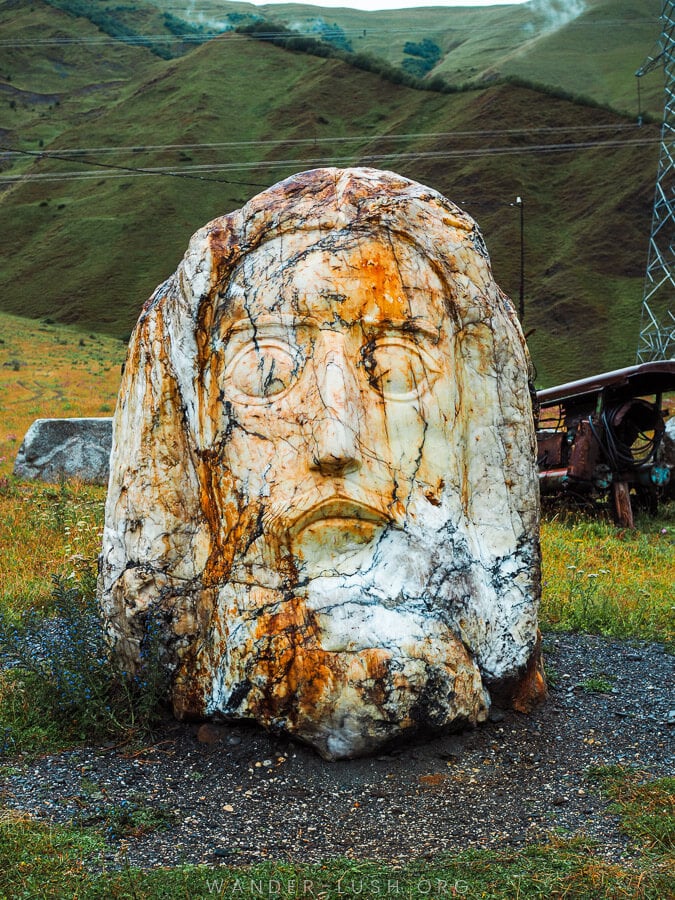
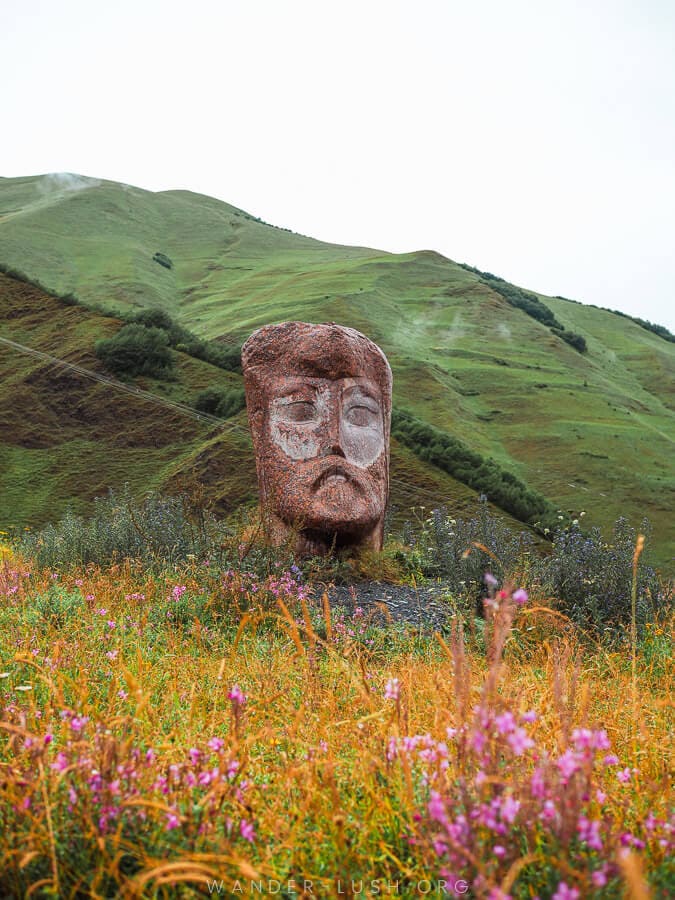
East of Sno, it’s the rugged heart of Kazbegi National Park and the Chaukhi Pass, one of the country’s premier hiking spots. The nearby village of Juta is a nice alternative to Kazbegi if you’re looking for something off-the-beaten-track. Fifth Season Cabin, a wonderful mountaineer’s hut nestled among snow-capped peaks, is one of Georgia’s coolest accommodations.
Bonus stop: Sno Castle
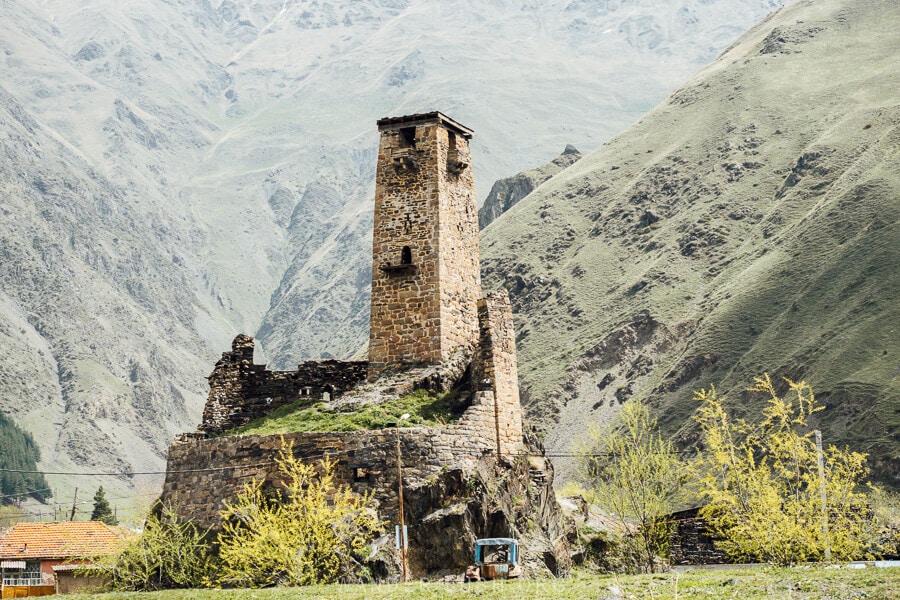
Drive a little further into Sno and you will see the Patriarch’s residence and Sno Castle, a tower residence that emerges from the earth right in the centre of town.
There are more stone towers in the Kazbegi area – see the next bonus stop below.
11. Pansheti Swimming Pool
- Travel time from Sno: 20 minutes
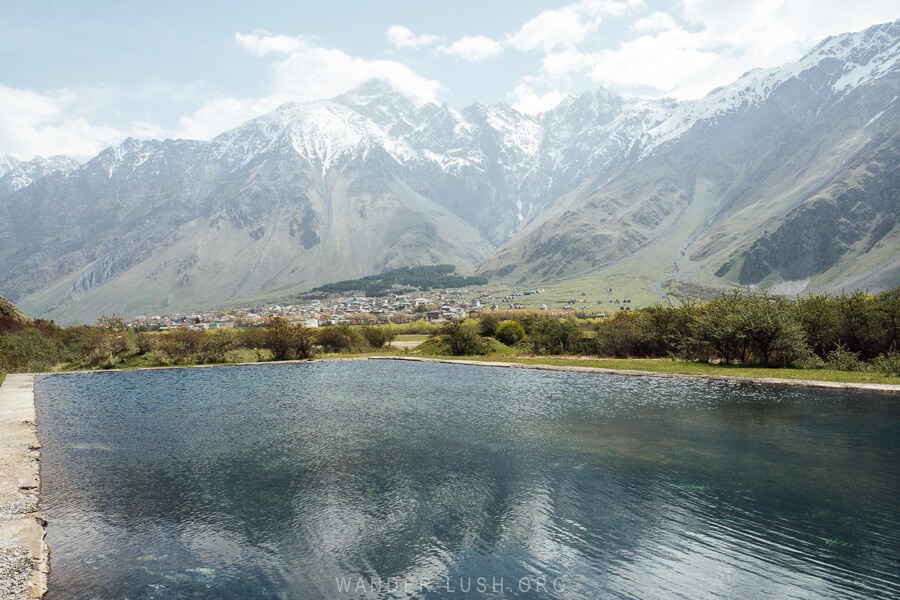
This all-natural, open-air spring water pool is located 2.5km from Kazbegi on the opposite side of the highway and river to Sno. Fed by mineral water springs that are channelled through a large pipe, the pool is icy cold and very refreshing on a hot summer’s day.
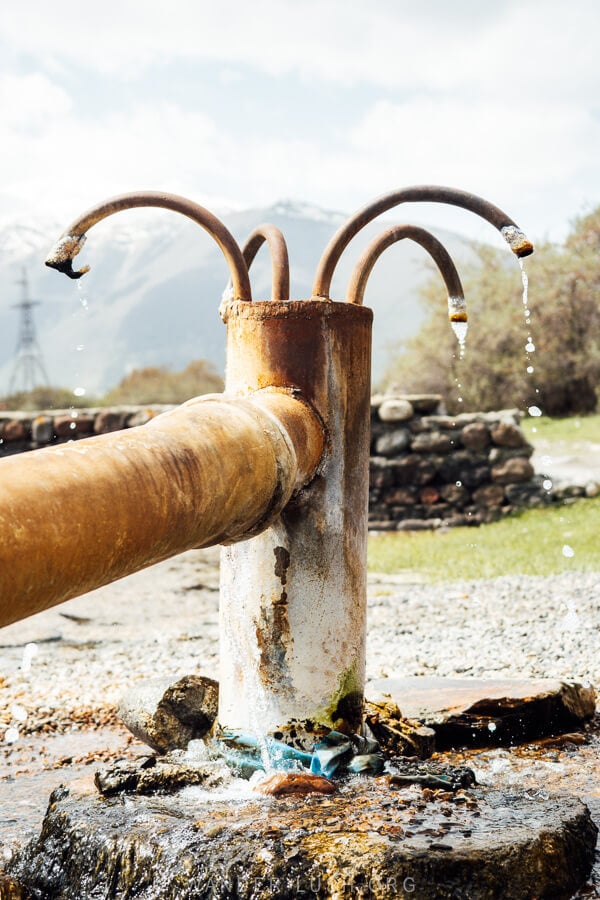

The pool is very large and looks out towards a panoramic view of Kazbegi town and the mountains beyond.
From Pansheti, it’s another 5 minutes to Kazbegi. As you approach the town, Gergeti Trinity Church will start to come into view. You might realise why locals have nicknamed the church ‘The Bride’ – the church is often shrouded in fog as a bride’s face is veiled.
Bonus stop: Pansheti stone towers
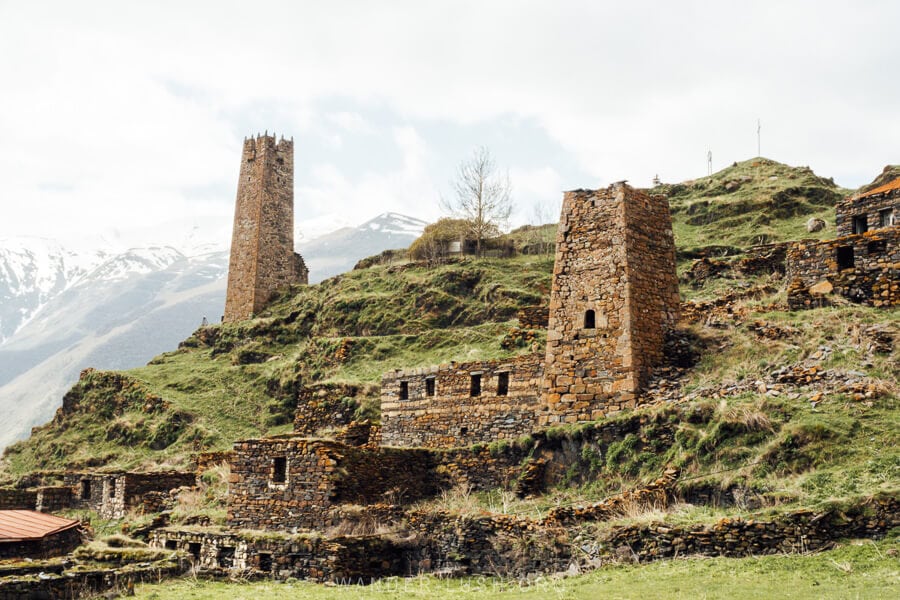
You expect to see stone towers in the high mountains of Tusheti, Svaneti and Khevsureti – but Kazbegi region has towers too.
In addition to Sno Castle, there are more stone defensive dwellings located in the vicinity of Pansheti. This ancient arrangement is particularly charming, with low houses embedded in the hillside and a few towers rising up above.
The towers date to the 17th century and served as a refuge for villages to shelter during invasions. Today there is a different kind of threat in this area… Dogs. Be very careful near the towers as are a few aggressive sheep dogs around. There are no dogs near the Pansheti Pool.
12. Terek Valley & Dariali Monastery
- Travel time from Pansheti: 25 minutes
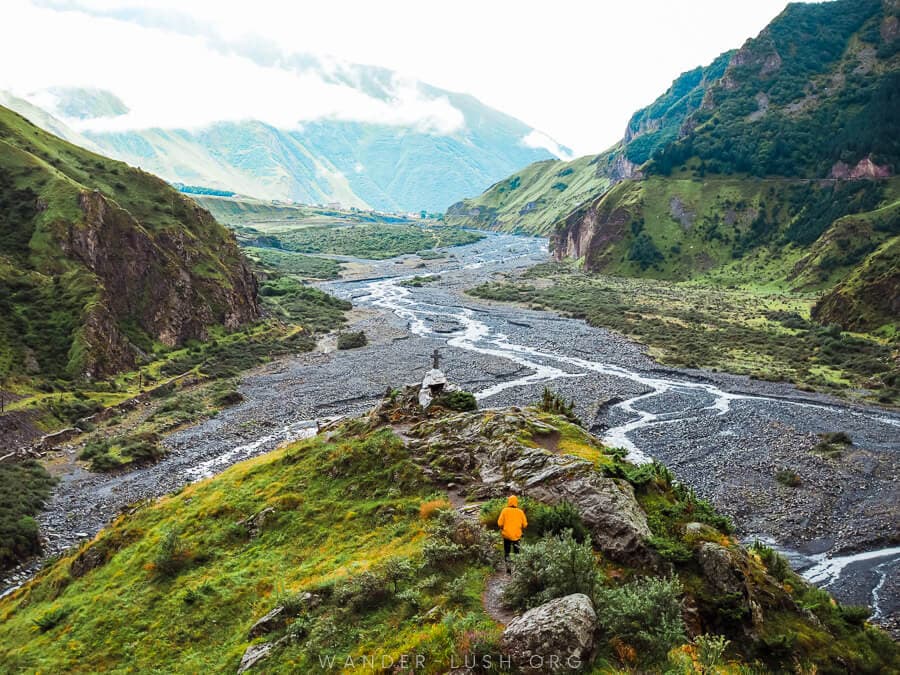
If you have time to continue on the Georgian Military Highway past Kazbegi, head to Dariali Gorge or Terek River Gorge, located a further 6km up the road. It’s a slight detour, but the views over the river basin are more than worth the extra drive time.
The road narrows after Kazbegi, creating the illusion that you’re clinging to the side of the cliff. As you approach the village of Tsdo, you pass through an unlit tunnel – this makes the moment you emerge into the belly of the valley all the more impressive. The scenery only gets more and more breathtaking from here.
The lookout point just after Tsdo offers amazing views over the rocky cleft that runs all the way to the Russian border. There is a small monument on the edge of the cliff and a church off in the distance.
If you have time, the nearby Dariali Monastery Complex and Gveleti Waterfalls are also worth a visit. Find more details in my guide to the best things to in Kazbegi and my list of the top day trips from Kazbegi.
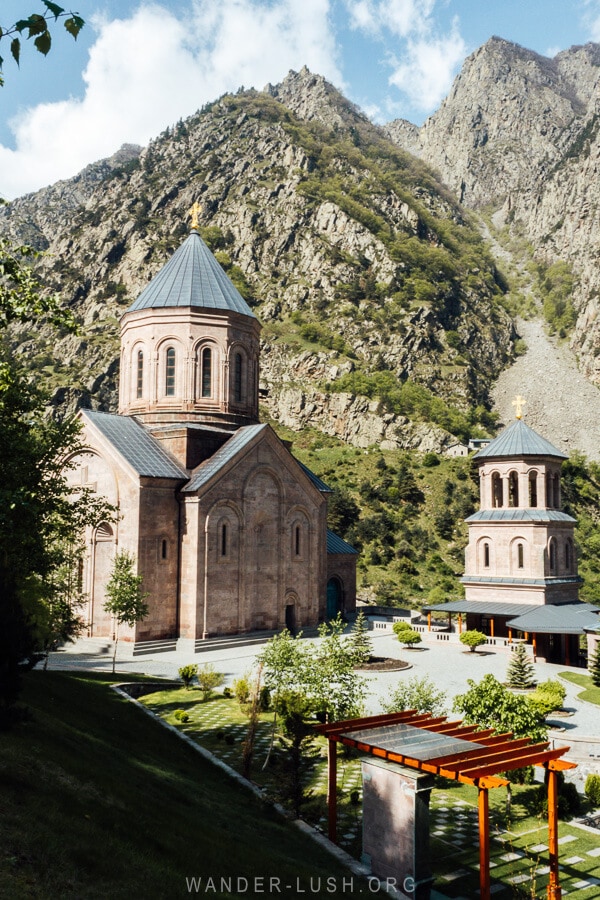
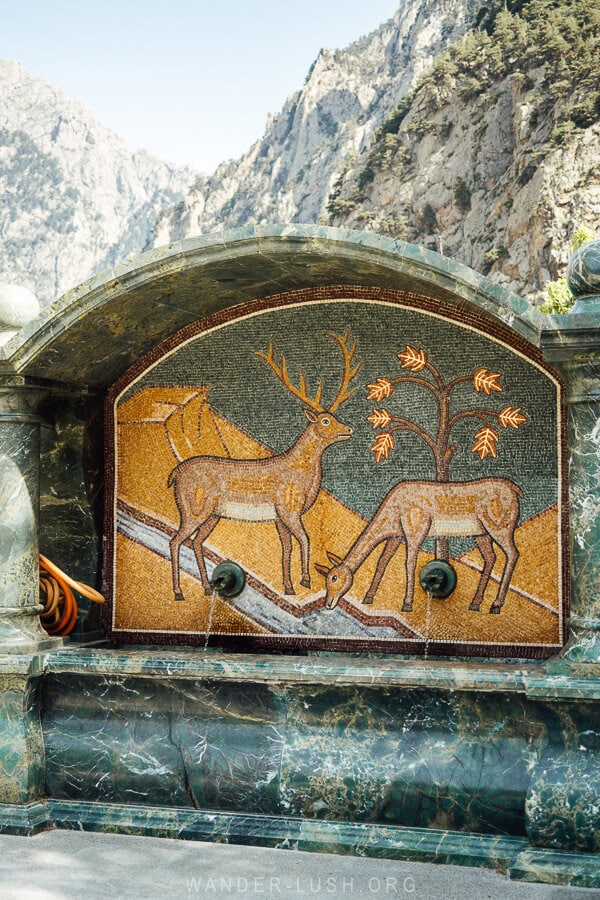
Georgian Military Highway map
Click here to access an interactive map of the Georgian Military Highway on Google Maps.
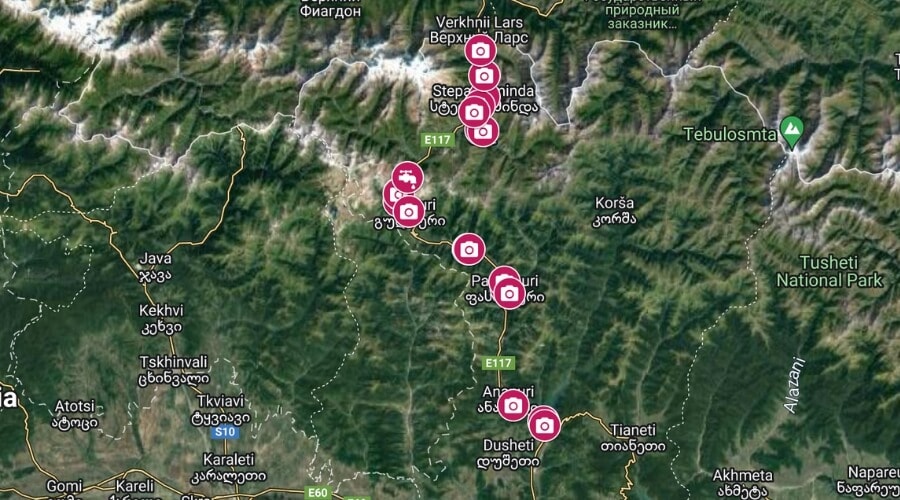
Georgian Military Road FAQ
How long does it take to drive the Military Highway from Tbilisi to Kazbegi?
If you were to drive directly from Tbilisi to Kazbegi, the journey would take just 3-3.5 hours on average. If you are making lots of stops and some detours to the points of interest mentioned in this guide, then you will need significantly longer to do the drive justice.
I recommend setting aside a full day for the journey. That means starting at 9am (or even earlier if you can manage it) and arriving in Kazbegi in the late afternoon. If you plan to make all these stops, then you need around 7-8 hours total depending on your pace.
When planning your departure time, note that Jvari Monastery in Mtskheta opens at 9.30am and Ananuri Fortress opens at 9am.
Of course you can draw the journey out even more and spend several days exploring the area. This is a good idea if you are self-driving and want to break the actual driving up into smaller, more manageable chunks.
Do you need a 4×4 to drive to Kazbegi?
The short answer is no, you do not need a 4×4 to drive the Military Highway. The highway is fully sealed. As with all roads in Georgia, there might be rough patches or unexpected roadworks, so it can help to have a car with high clearance. But a regular SUV (such as a Prius) is absolutely fine.
Is the Military Road safe?
This is definitely one of the more challenging roads to drive in Georgia. I am a very confident driver and personally I would not feel comfortable driving myself – I much prefer to ride with a local who is familiar with conditions and knows what they are doing.
Hairpin bends (and speeding/overtaking drivers on those bends!) are the main issue. There can also be heavy traffic from freight lorries, and sometimes one entire lane of the road is blocked by parked trucks waiting to cross the border.
This problem is being addressed now with the construction of a new tunnel and an expansion of the border checkpoint. Work is still ongoing, with the main tunnel set to open in 2025.
When is the best time to travel?
Late spring (late May to mid June) and autumn (especially the month of September) are by far the nicest times of year to visit Kazbegi and drive around this area. The weather is temperate, the colours are nice, the wildflowers are out in spring, and it’s not too crowded yet.
The highway is stunning to drive during winter, and this is by far the best time to ride the Kobi-Gudauri cable car. But there is a lot you miss out on because of the snow coverage.
When I went up for Christmas one year we couldn’t make any stops because it was so snowy and grey.
Can you get to the Military Highway From Kakheti?
If you’re coming from Kakheti Wine Region (Sighnaghi or Telavi) then it’s possible to take a shortcut through Tianeti and join up with the Military Highway at Zhinvali. This means you don’t have to drive all the way back through Tbilisi – plus you get to make a few bonus stops along the way.
Travel tips for the Georgian Military Road
- The Georgian Military Highway is open year-round. However, sections of the road are sometimes closed in winter due to avalanche risk or in spring due to rockfall. Check ahead with a local or call the roads department before you travel.
- To see all the stops listed here, I highly recommend hiring a car and an experienced driver. GoTrip.ge is an affordable, reliable service that gives you complete flexibility.
- The road is windy in parts. If you suffer from motion sickness, make sure you have your preferred medication on hand.
- Without stops, it takes around 3-3.5 hours to travel between Tbilisi and Kazbegi. With the 12 recommended stops, you should set aside a full day (7-8 hours) to see everything at a comfortable pace.
Where to stay in Kazbegi

TOP CHOICE OVERALL: Rooms Kazbegi (⭐ 8.9). For a truly memorable Georgian mountain experience, don’t look past Rooms Kazbegi. Housed in a converted sanatorium, this is one of the coolest boutique hotels in the whole country.
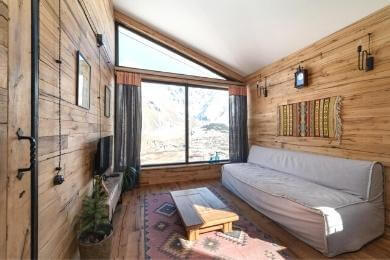
BEST CABIN: Kazbegi Cabins (⭐ 8.7). Kazbegi Cabins offers luxurious wooden cabins with hand-crafted furniture, a wood-burning stove and a nice onsite cafe-coworking space.

BEST BOUTIQUE HOTEL: Intourist Kazbegi (⭐ 8.7). This new hotel has chic furnishings and a retro aesthetic, panoramic mountain views, and a great breakfast buffet.

BEST MID-RANGE HOTEL: Hotel Stancia (⭐ 9.1). Located in the centre of town near the bus stop, Hotel Stancia is chic, modern, and still very affordable. The onsite restaurant is very good, and there are beautiful mountain views from the deck.

BEST BUDGET GUESTHOUSE: Red Stone Guest House (⭐ 9.6). This family-run guesthouse is warm and spacious. An incredible home-cooked breakfast comes included, and it’s conveniently located close to the Gergeti Trinity trailhead.
→ Find plenty more options in my full guide to the best Kazbegi accommodations.
Georgia essentials
Here are the websites and services I personally use and recommend for Georgia. Check out my full list of travel resources for more tips.
FLIGHTS: Search for affordable flights to Tbilisi, Batumi or Kutaisi on Skyscanner.
TRAVEL INSURANCE: Insure your trip with HeyMondo, my preferred provider for single-trip and annual travel insurance (get 5% off when you book with my link).
SIM CARD: Magti is my preferred provider, with prices starting from 9 GEL/week for unlimited data. See this guide for all the details about buying a Georgian SIM card.
AIRPORT TRANSFERS: Most flights into Georgia arrive in the early hours. For ease, pre-book a private transfer from Tbilisi Airport to your hotel (from $17) or from Kutaisi Airport to Tbilisi (from $90) with my partners at GoTrip.ge.
ACCOMMODATION: Booking.com is the most widely used platform in Georgia. Use it to find family guesthouses, private apartments, hostels and hotels around the country.
CAR HIRE: Find a great deal on a rental car in Georgia – use the Local Rent website to book through a local agent (prices start from $20/day).
DAY TRIPS & CITY TOURS: Use Viator or Get Your Guide to browse a range of day trips and city tours. For off-beat programs, I recommend Friendly.ge (use the promocode wanderlush for 10% off). For in-depth day trips to Georgia’s wine regions, I recommend Eat This! Tours (use the promo code wanderlush for 5% off).
PRIVATE TRANSFERS: GoTrip.ge is a terrific service for booking a private professional driver and car for the day. Use it for A-to-B transfers, a customised round-trip itinerary, or a multi-day trip. You can stop wherever you like for as long as you like without the fixed price going up.
NEED SOME HELP?: Need feedback on your itinerary or personalised travel tips? I offer a one-on-one consultation call service for Tbilisi and Georgia. More information and bookings here.
Georgian Military Highway: Save it on Pinterest
